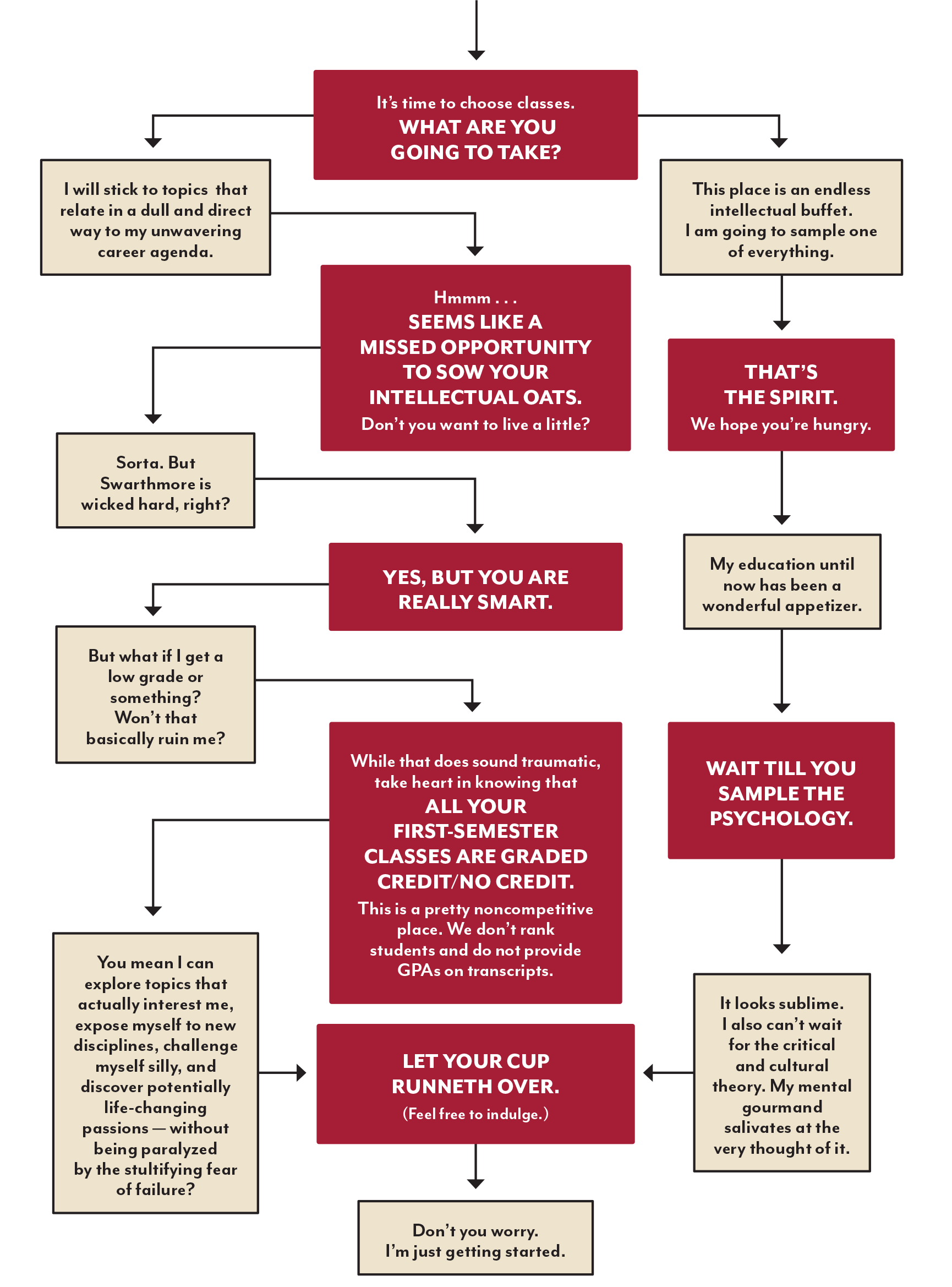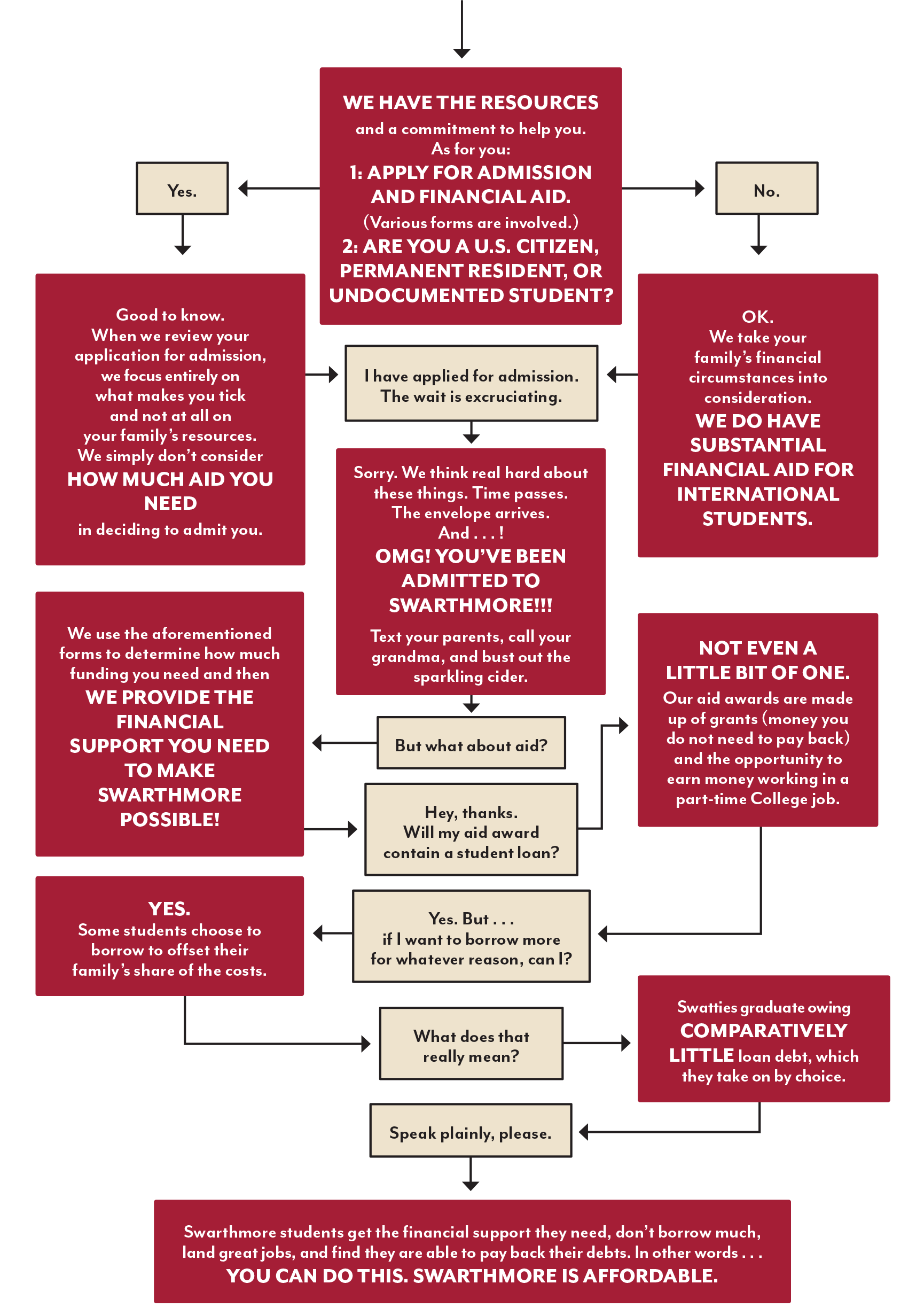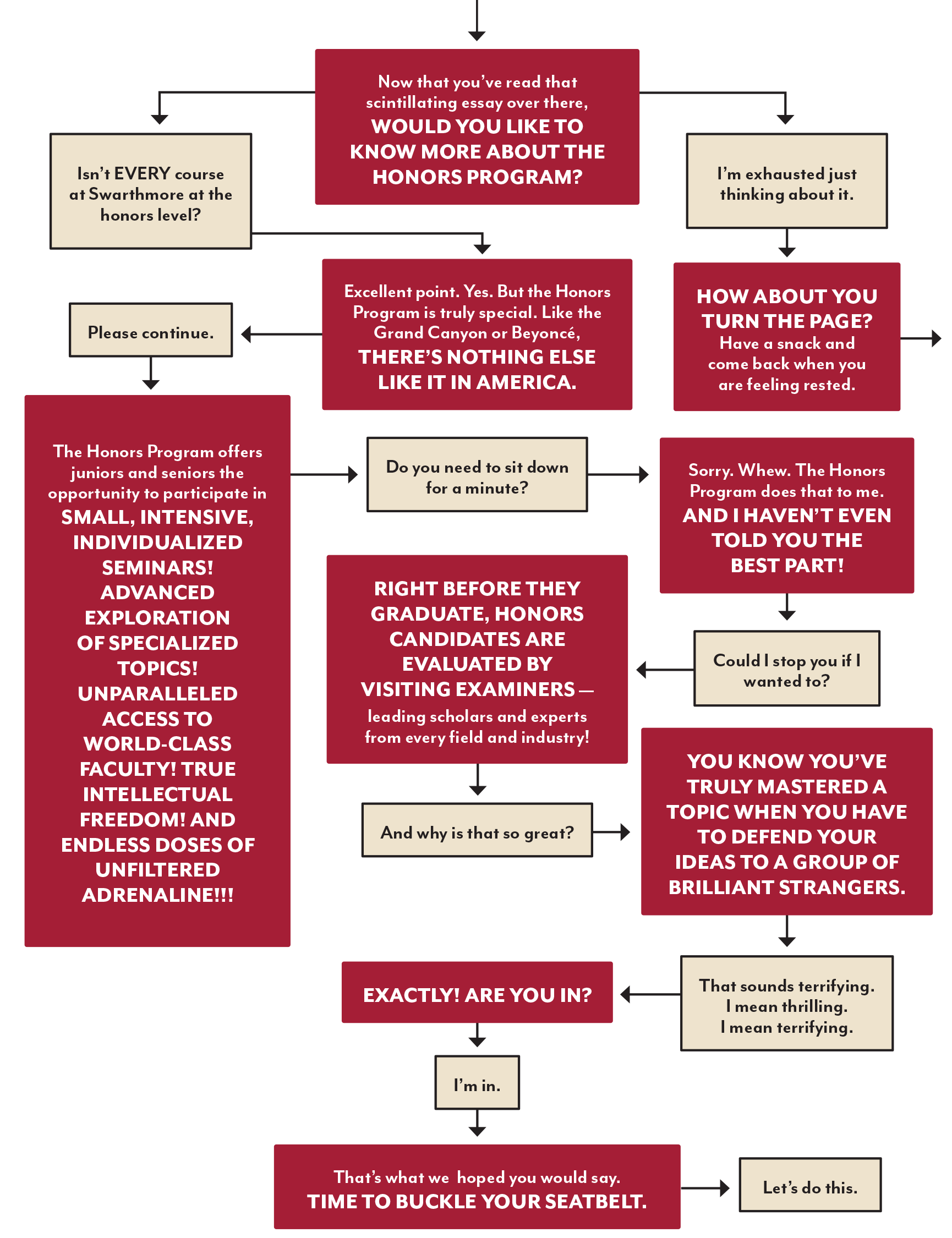what college
will look like.
Well, at least you’re being honest.
Is that even possible these days?
I’m skeptical.
we can’t promise that college life
will look exactly the way it does in this book.
but we can promise that swarthmore
will prepare you to do amazing things.
Isn’t that a whole lot of marketing blah blah blah?
and neither do you.
Reluctantly.
I appreciate the effort.
Yes, yes. But let’s get on with it. I’m extremely busy.
Tell me about Swarthmore. What kind of school is it?
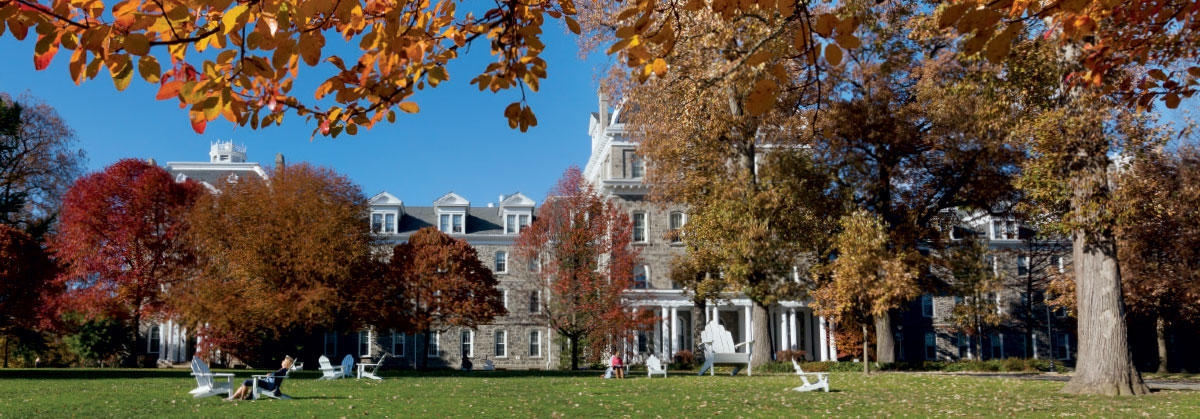
of creators, dissectors, and debaters, of problem finders and problem solvers — gets inside your head. As you help shape this place, it shapes you: your way of looking at the world, your way of interacting with it, your way of making it better. After four years as a Swattie, you’ll emerge prepared to work with others to make things happen. Whether that means engineering new technology, advancing sustainability research, starting a microfinance incubator, or holding a mirror up to your country or century, as a Swattie you’ll have what it takes to apply your knowledge with meaning and purpose.
matter what
courses you
take.
What ultimately matters
is that you
took them
at swarthmore.”
Swarthmore’s Clothier Hall bell Tower, like the College itself, is no ivory edifice. Flanked by the Hormel-Nguyen Intercultural Center at Sproul Hall, it looks out on Philadelphia, the sixth-largest city in the country. Whether living on campus or learning remotely, Swarthmore students have all they need for a rich intellectual and social experience — one that readies them to make a difference in the world.

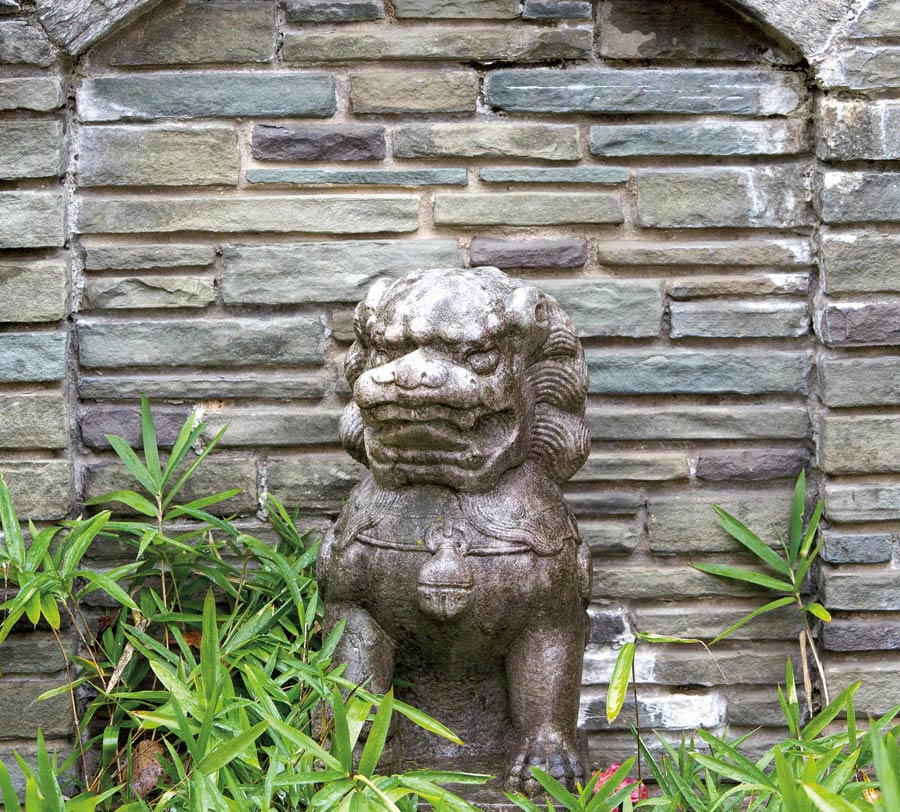
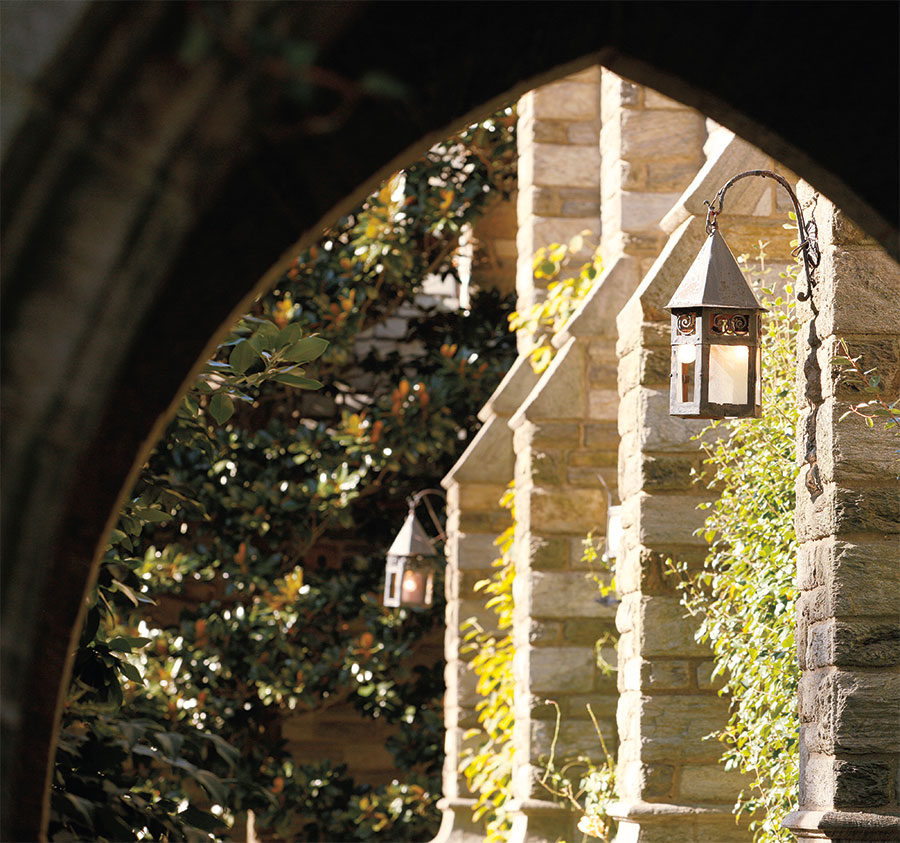
244
Fulbright Grants, Marshall Scholarships, Mellon Mays Undergraduate Fellowships, National Science Foundation Fellowships, and Rhodes Scholarships.

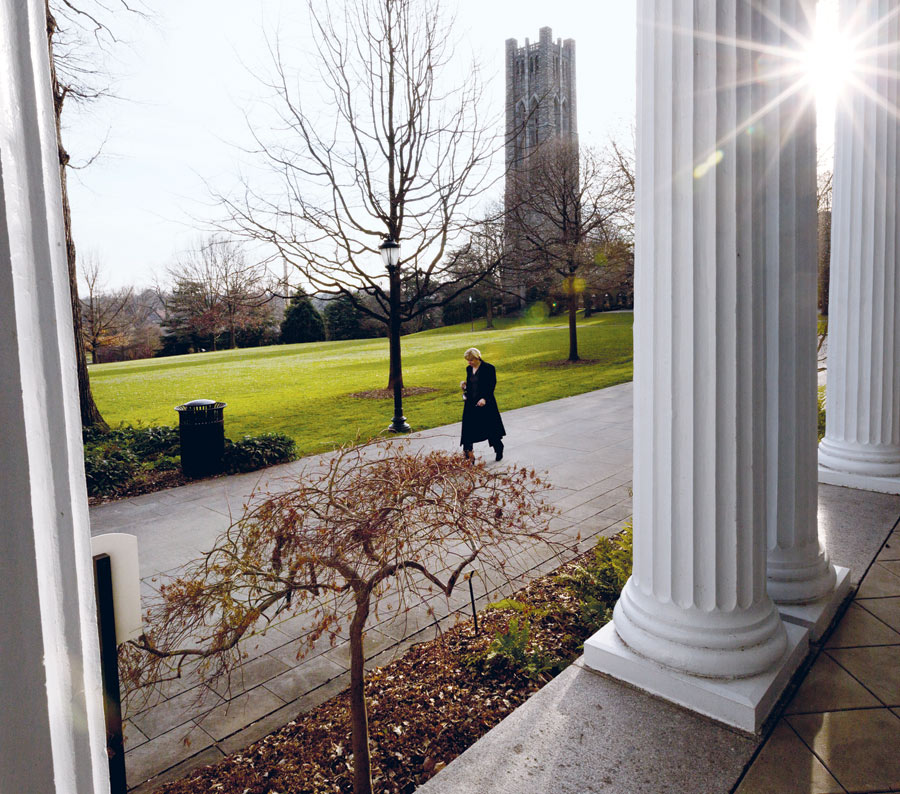
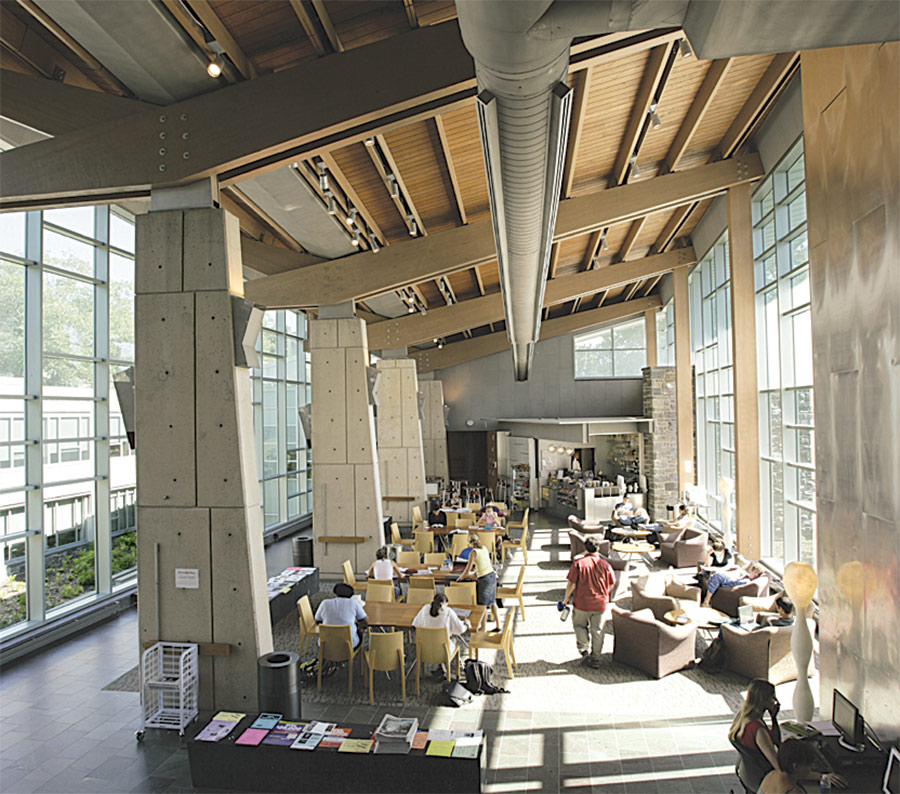
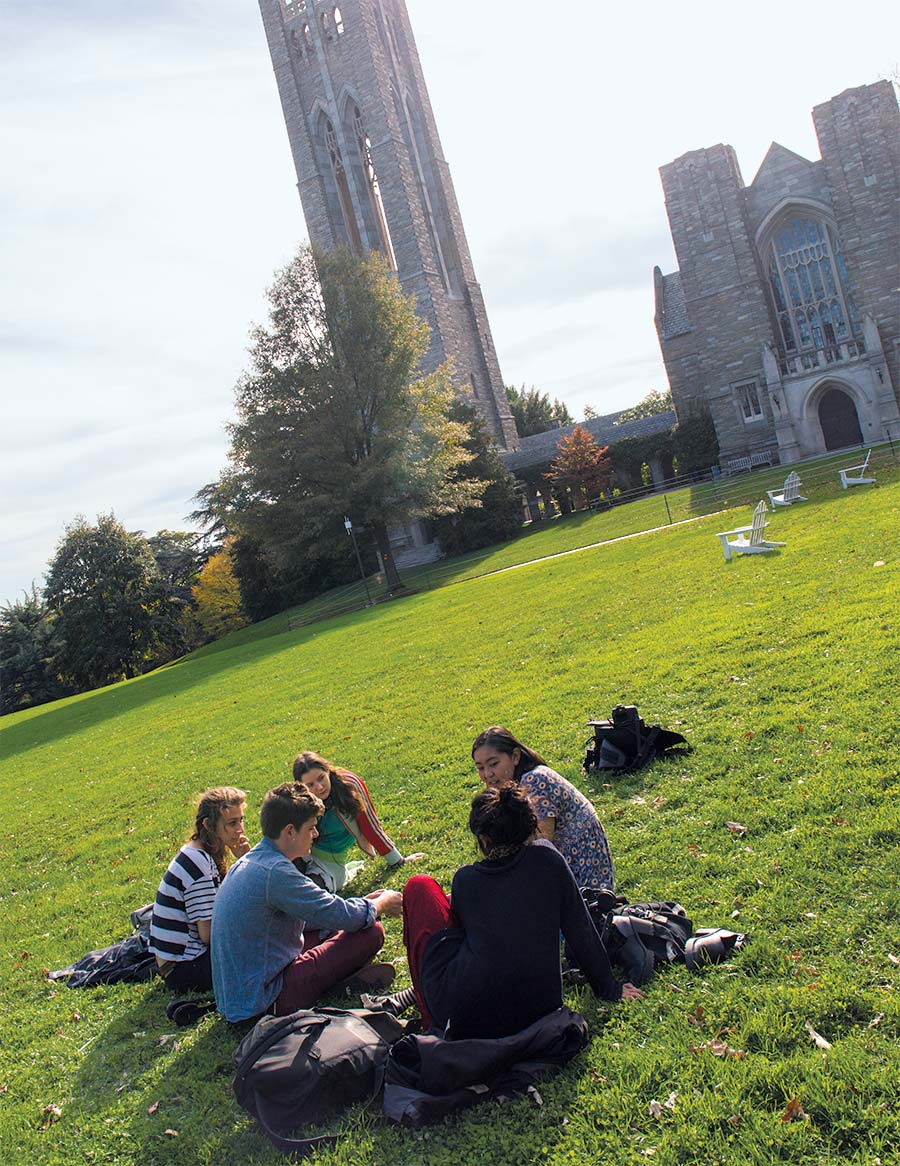
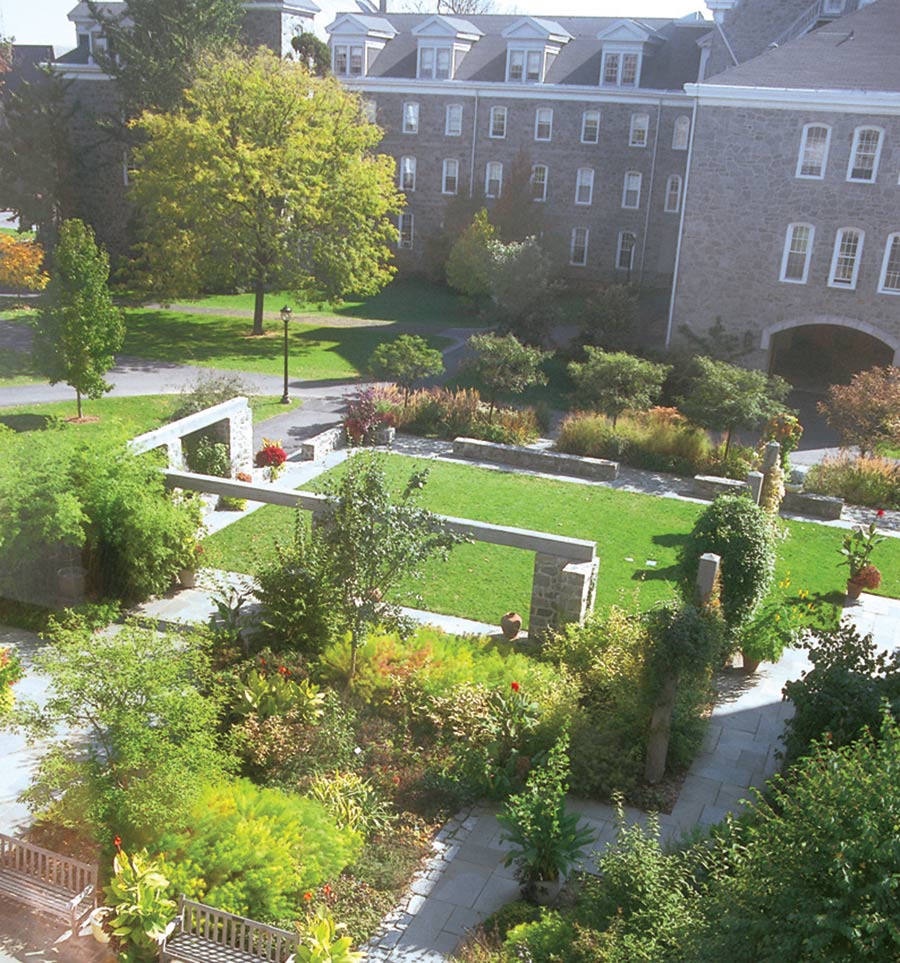
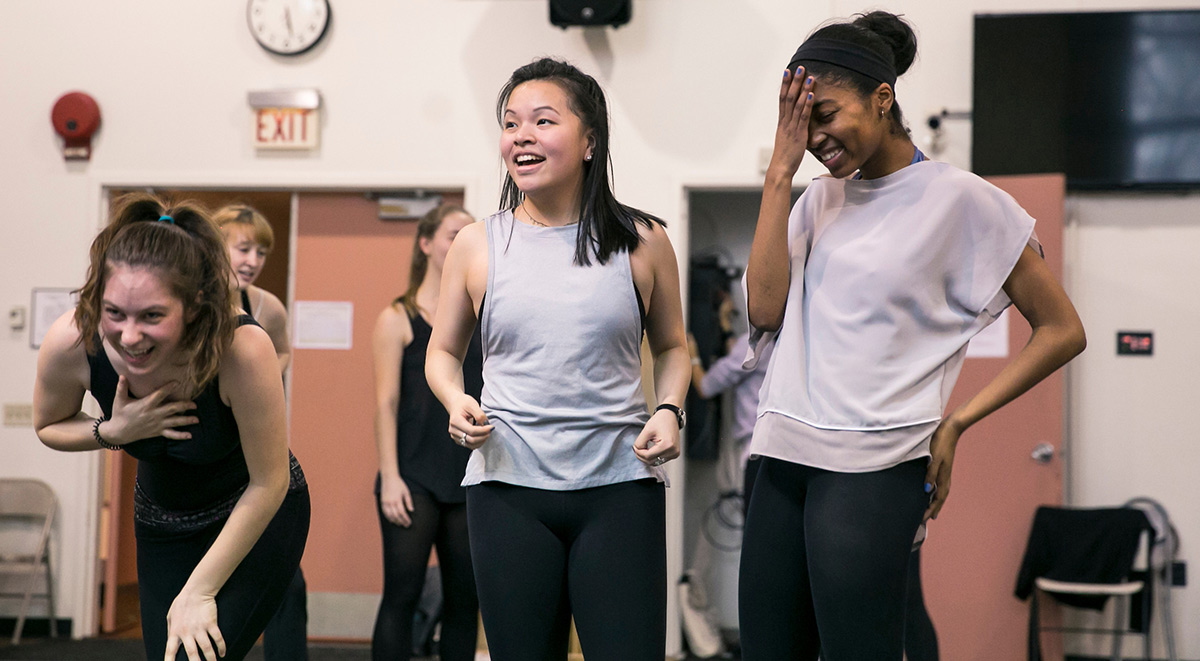

more challenging = more FUN.
Every course in Swarthmore’s liberal arts curriculum is designed to make students think. Hard. Which means that classmates work together, laugh together (sometimes even from different time zones), explore together, and end up discovering more than they thought possible.
“Street Children in Zimbabwe” | “Sense from Nonsense: A Linguistic and Literary Analysis of Two ASL Translations of ‘Jabberwocky’” | “Fuel-Cell Car” | “HIV Prevention: Reducing Infectivity by Breaking Down Amyloid Fibers”
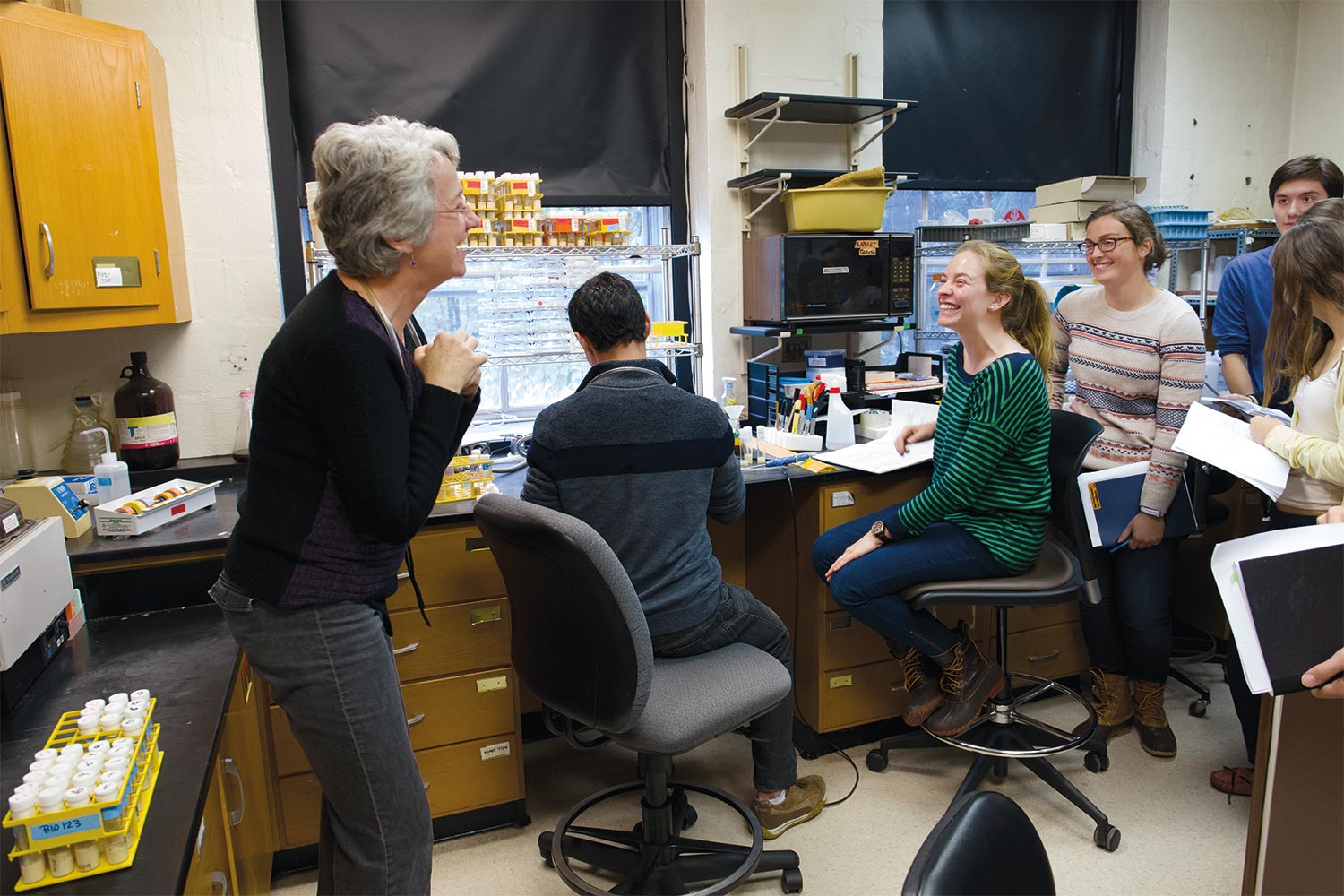
more challenging = more FUN.
Every course in Swarthmore’s liberal arts curriculum is designed to make students think. Hard. Which means that classmates work together, laugh together (sometimes even from different time zones), explore together, and end up discovering more than they thought possible.
“Street Children in Zimbabwe” | “Sense from Nonsense: A Linguistic and Literary Analysis of Two ASL Translations of ‘Jabberwocky’” | “Fuel-Cell Car” | “HIV Prevention: Reducing Infectivity by Breaking Down Amyloid Fibers”
MOTIVATION?
It’s not a superficial reward. That’s a pat on the head.
It’s not something dangled in front of you. That’s a carrot.
Then again, it’s hard to motivate in a vacuum.
Their courses are invitations for you to join them on their journeys.
MOTIVATION?
It’s not a superficial reward. That’s a pat on the head.
It’s not something dangled in front of you. That’s a carrot.
Then again, it’s hard to motivate in a vacuum.
Their courses are invitations for you to join them on their journeys.
EPIGENETICS • VISUAL ANTHROPOLOGY •
ARTIFICIAL INTELLIGENCE • EXISTENTIALISM

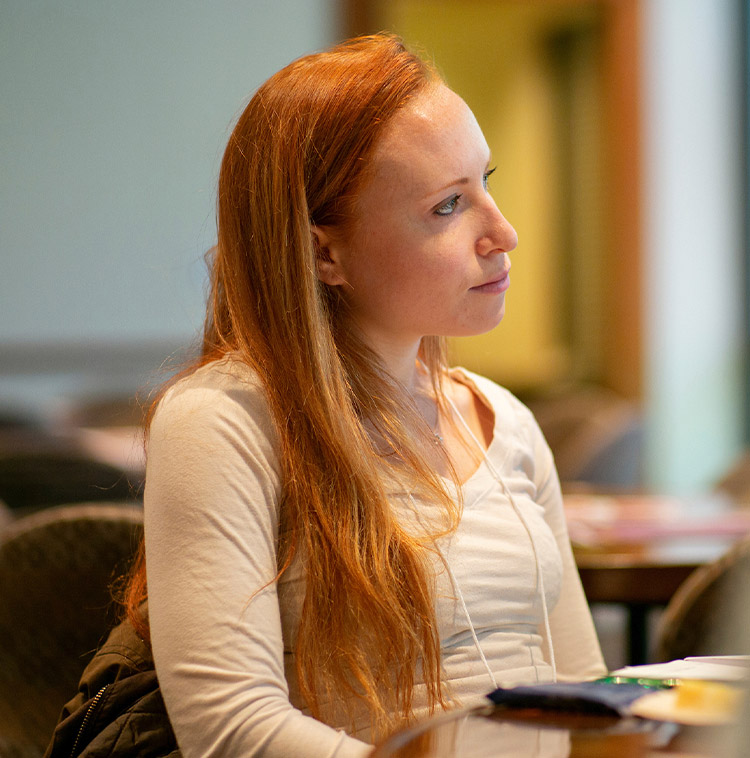

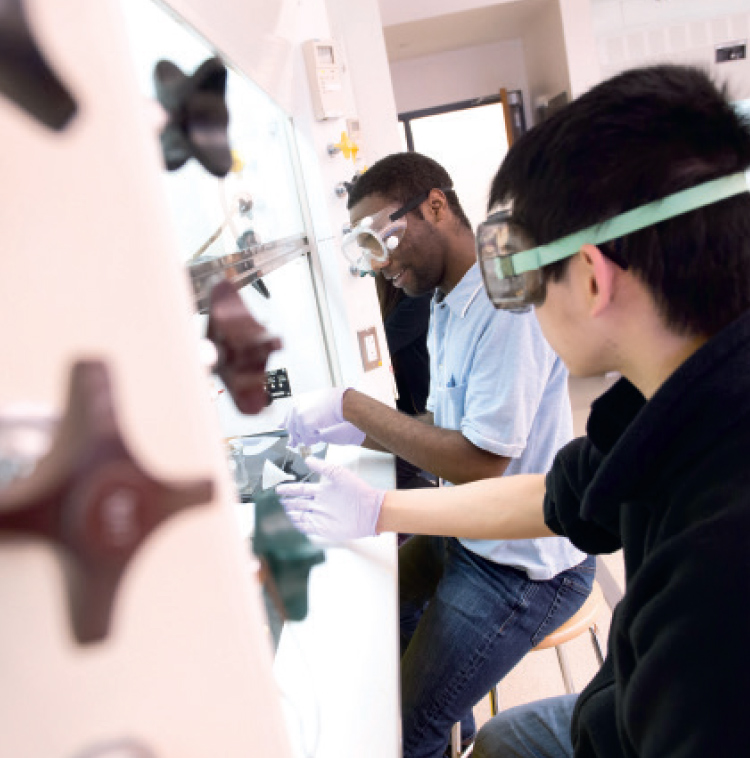

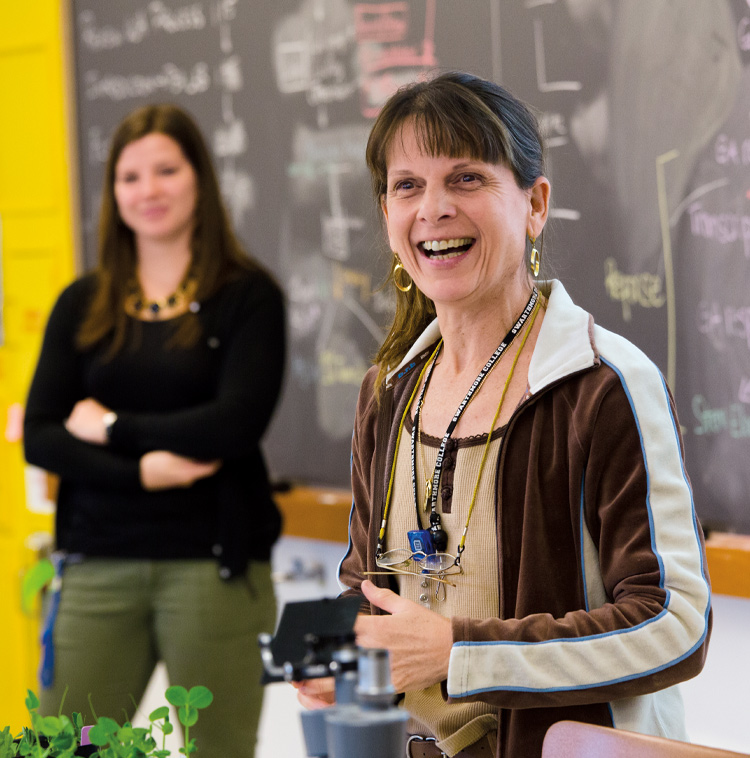
ANATOMY: BONES, MUSCLES, MOVEMENT
• MODERN AMERICAN POETRY • ENGINEERING
DESIGN • ELEMENTS OF MUSICIANSHIP •
TV AND NEW MEDIA • QUANTUM MECHANICS
• POLITICAL THEORY • ACTING • PLATO
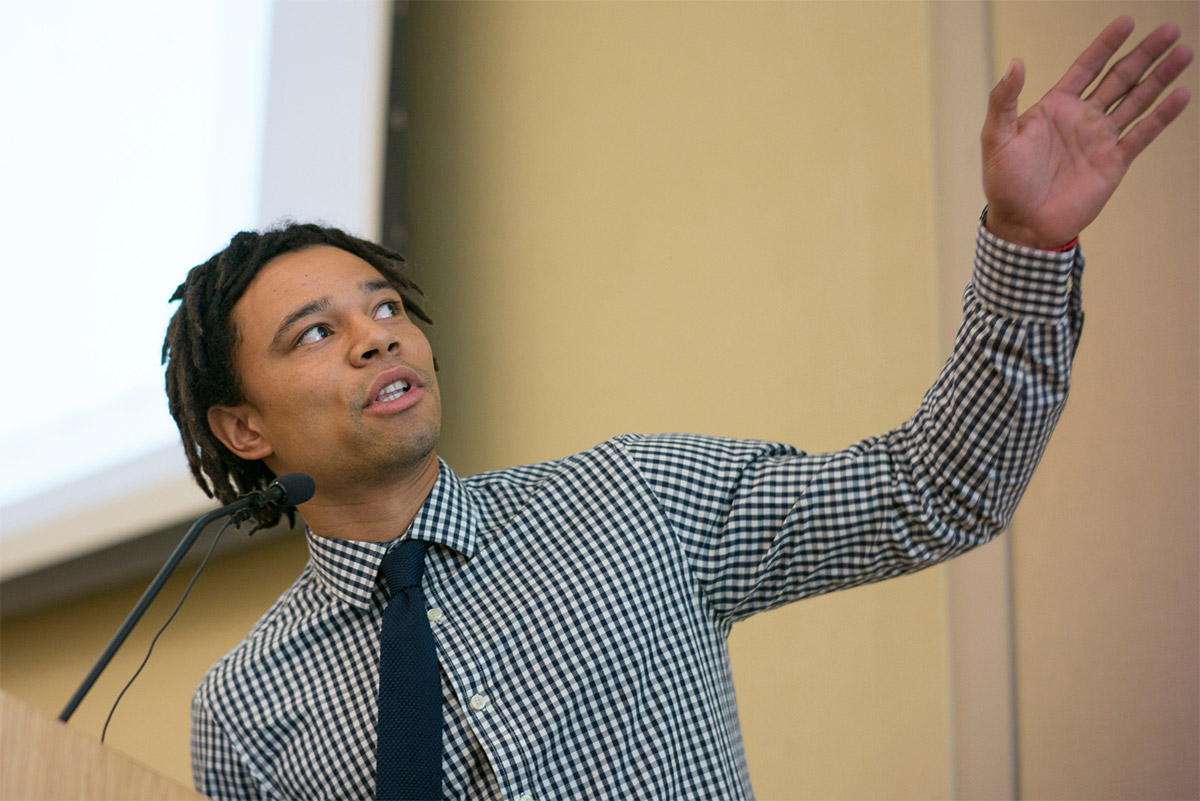
I want to know about a lot of things.”
IS TO LEARN.
INTELLECT.
NOW SHARE IT.
So you’re a chatty introvert? Or maybe you’re a contemplative extrovert. Either way, you’ll feel right at home.
The joy that Swarthmore students feel in pursuing the life of the mind is exponentially increased when they do it together.
Our campus thrives on open dialogue, simultaneous discovery, and collaborative exploration.
Whether you’re texting after class or chatting on the sun-drenched lawn of Parrish Beach, conversations here tend to challenge, inspire, and enlighten. Have an opinion? You’ll get plenty of practice defending it. Unsure where you stand on an issue? Check in with yourself an hour later.
Mention your latest project to fellow Swatties — even if they don’t share your major — and they’ll want to know more about it. Why did it capture your interest? What are the ramifications, implications, and applications? How might it relate to what they’re studying? Can they join you in class? . . .
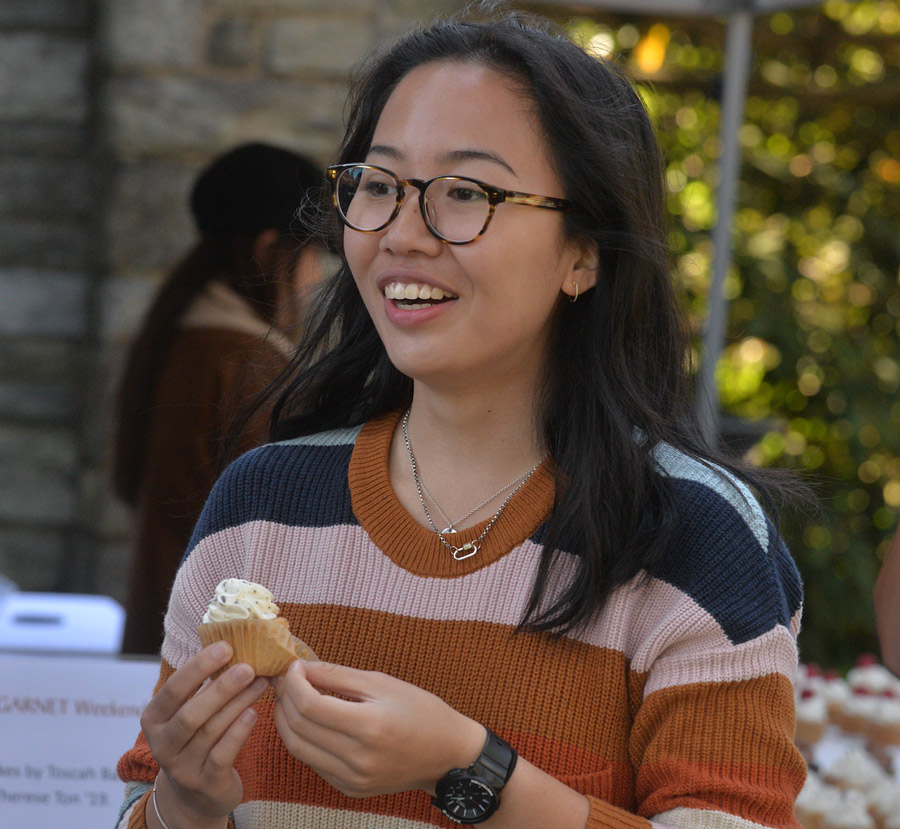
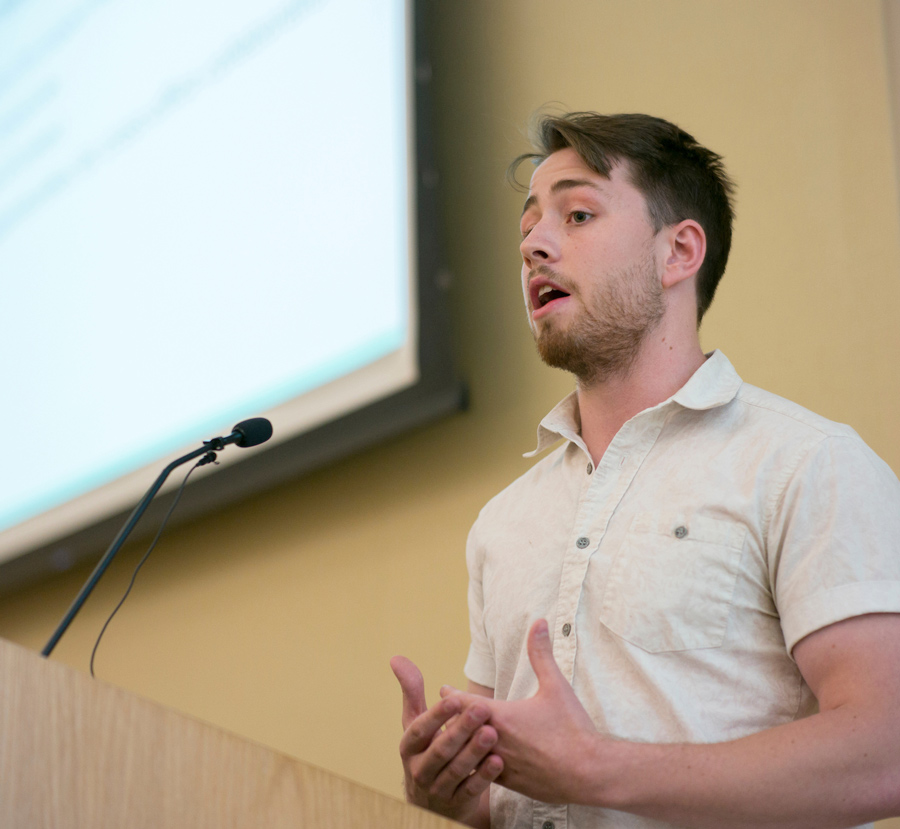
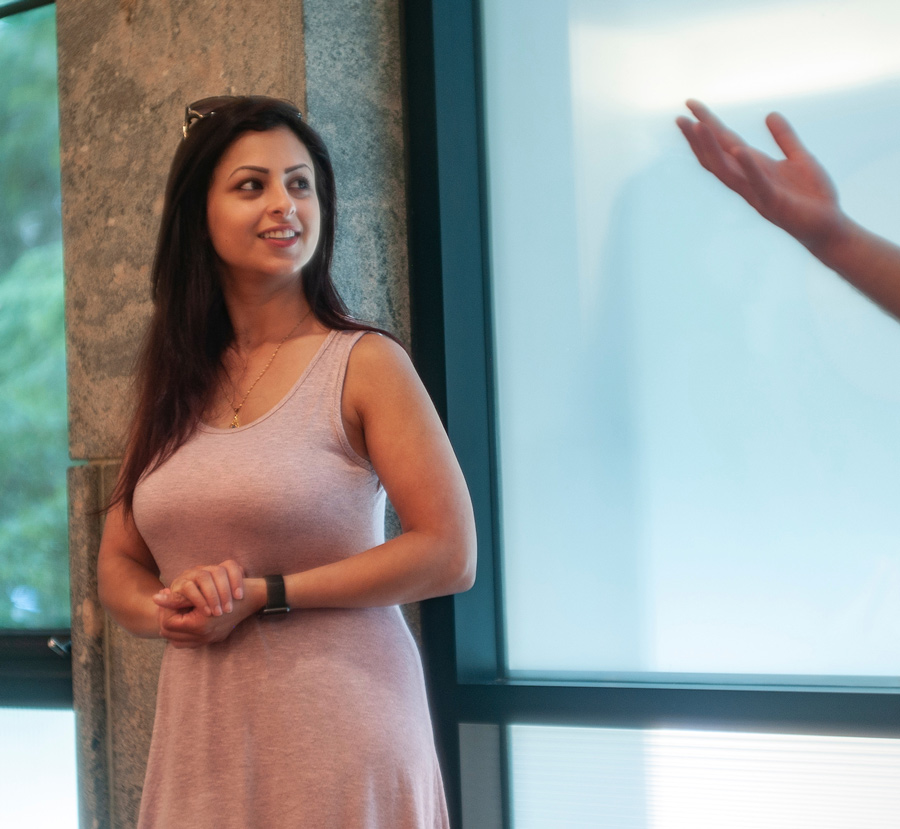

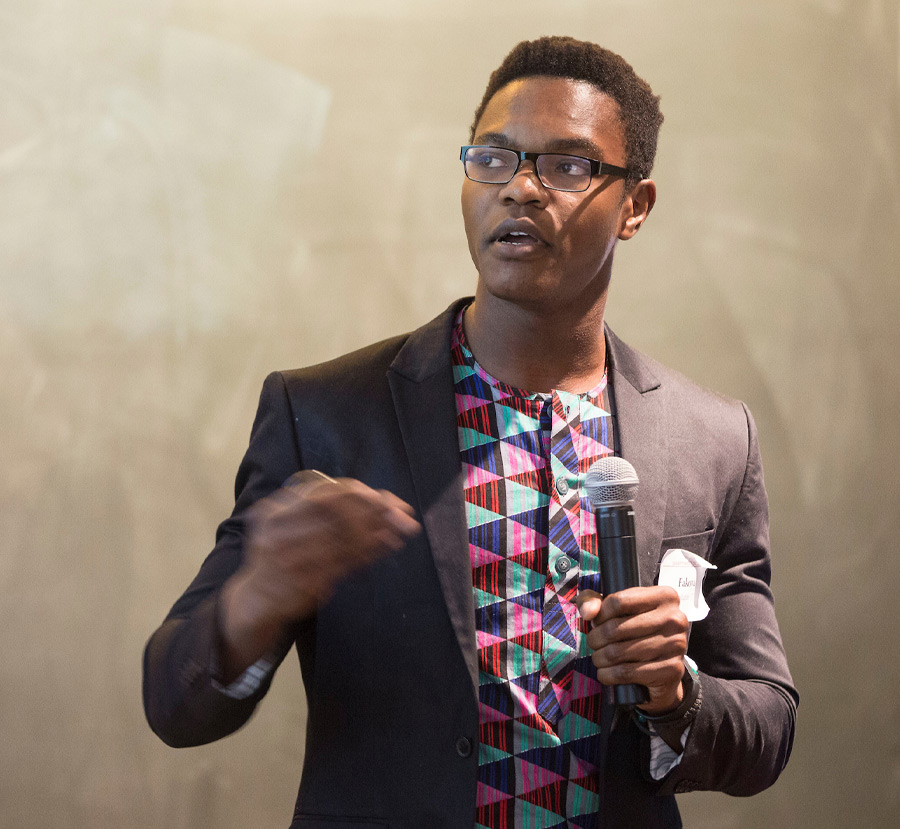

A gathering of more than 500,000 e-books, nearly 75,000 online journals, and more books than anyone could ever read, our seven libraries draw students together online and in person for conversation and caffeine — and for inspiration as they launch into the next project or paper. Concerned about textbook costs? Swarthmore’s tuition includes a $700 allowance per year for all students to help cover the cost of required course materials.
Urban Agriculture and Land-Use Policy | Alternative, Low-Power, Computer Architectures | Twi Language Research (in Ghana) | Mathematical Modeling for HIV/AIDS Virus | Designing a Polarizing Variable Angle Spectrometer
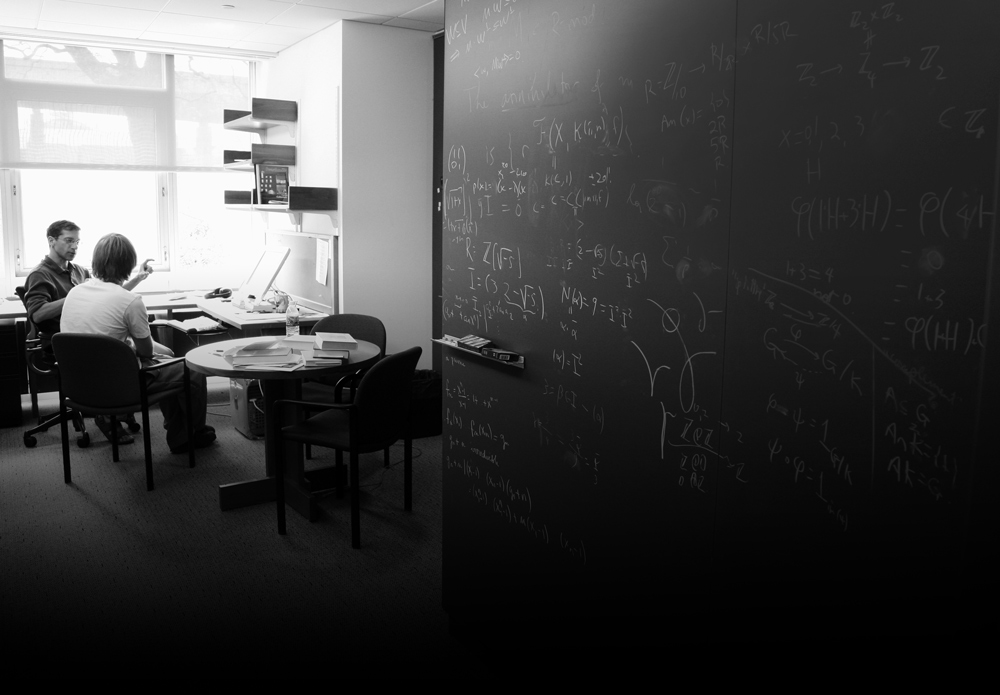
As one of only a few liberal arts colleges with an engineering department, Swarthmore gains an added dimension — and so do its students. Engineering students and faculty provide a problem-solving example to the rest of the community. In turn, the College’s fusion of technical and liberal education arms engineering students with communication skills — as well as a deep understanding of the social and economic implications of their projects — that can prove invaluable in distinguishing them from others in the workplace.
Swarthmore
Affordable?
Because this community is so tightly knit, what you do matters to those around you. You’re not joined at the hip — or even at the ear — but by all you have in common.
That means that even if you’re not studying physics, you’ll know someone who is. That when you tune in to WSRN 91.5 FM, you might not know the DJ, but you might recognize her voice from a conversation in a club meeting. That whether or not you typically enjoy sci-fi role-playing, you’ll probably want to join in the annual Pterodactyl Hunt — on campus or in an old-school internet RPG.
Self-discovery: At Swarthmore, it’s communal. As paradoxical as that may sound, it’s true in more ways than one. In processing feedback from faculty and peers, students sharpen their personal visions. In collaborating with others, they build self-reliance. In finding mentors, they discover themselves.



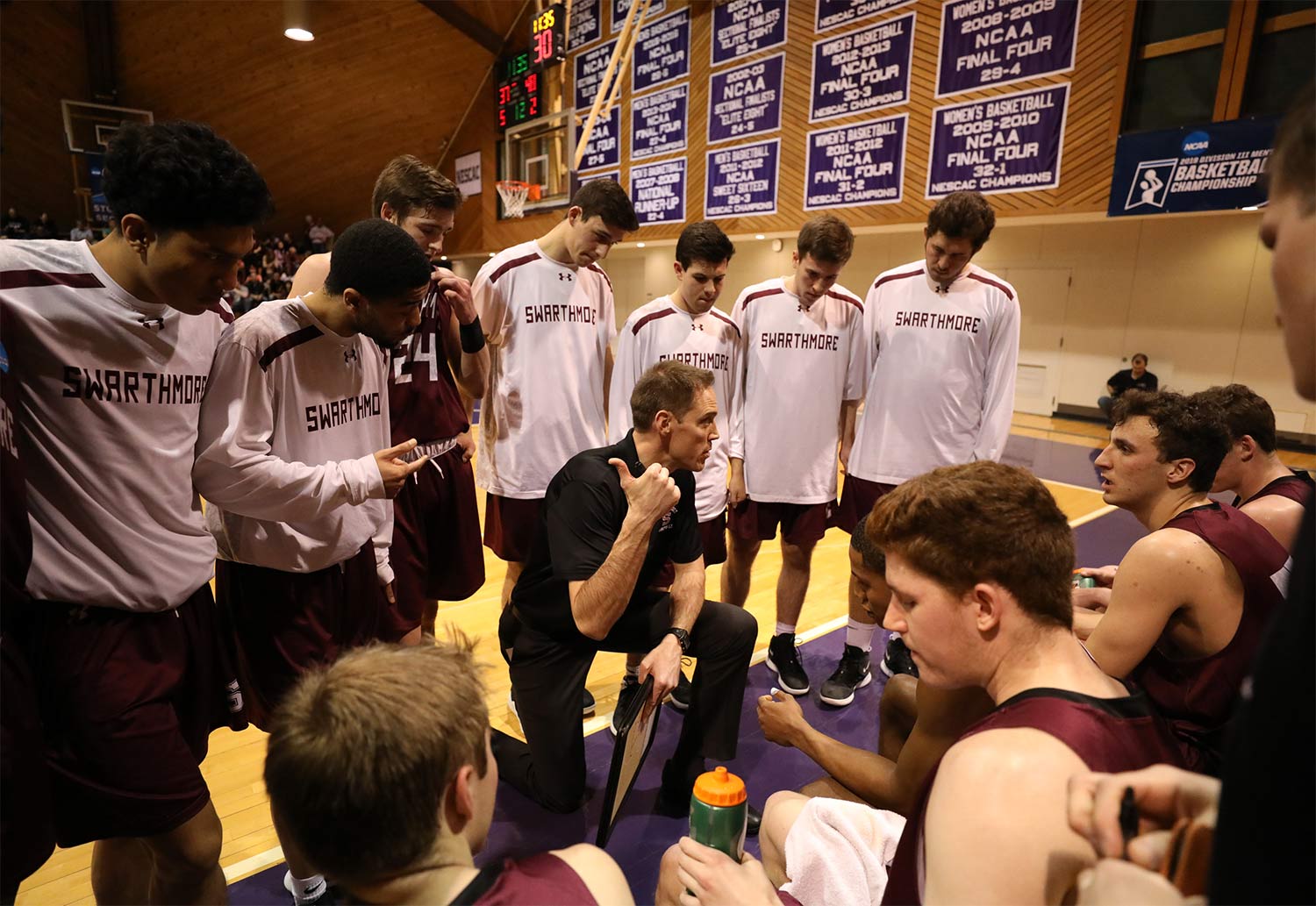
SEMINARS.

Despite my reservations about promotional brochures, I have learned a few things about Swarthmore.
And . . . ?
My reservations have temporarily deserted me.
Excellent. Do you need anything else?
A little peace and quiet.
Look around.
This campus is an actual arboretum.
No joke?
It was recently named the most beautiful campus in the known universe.
I’ve got a stack of beautiful viewbooks filled with pretty pictures.
But this ampHitheater is where graduation is planned every year.
It even looks good in the rain.
It really is quite beautiful. I’m feeling a little misty.
Do you need a tissue?
Thanks.
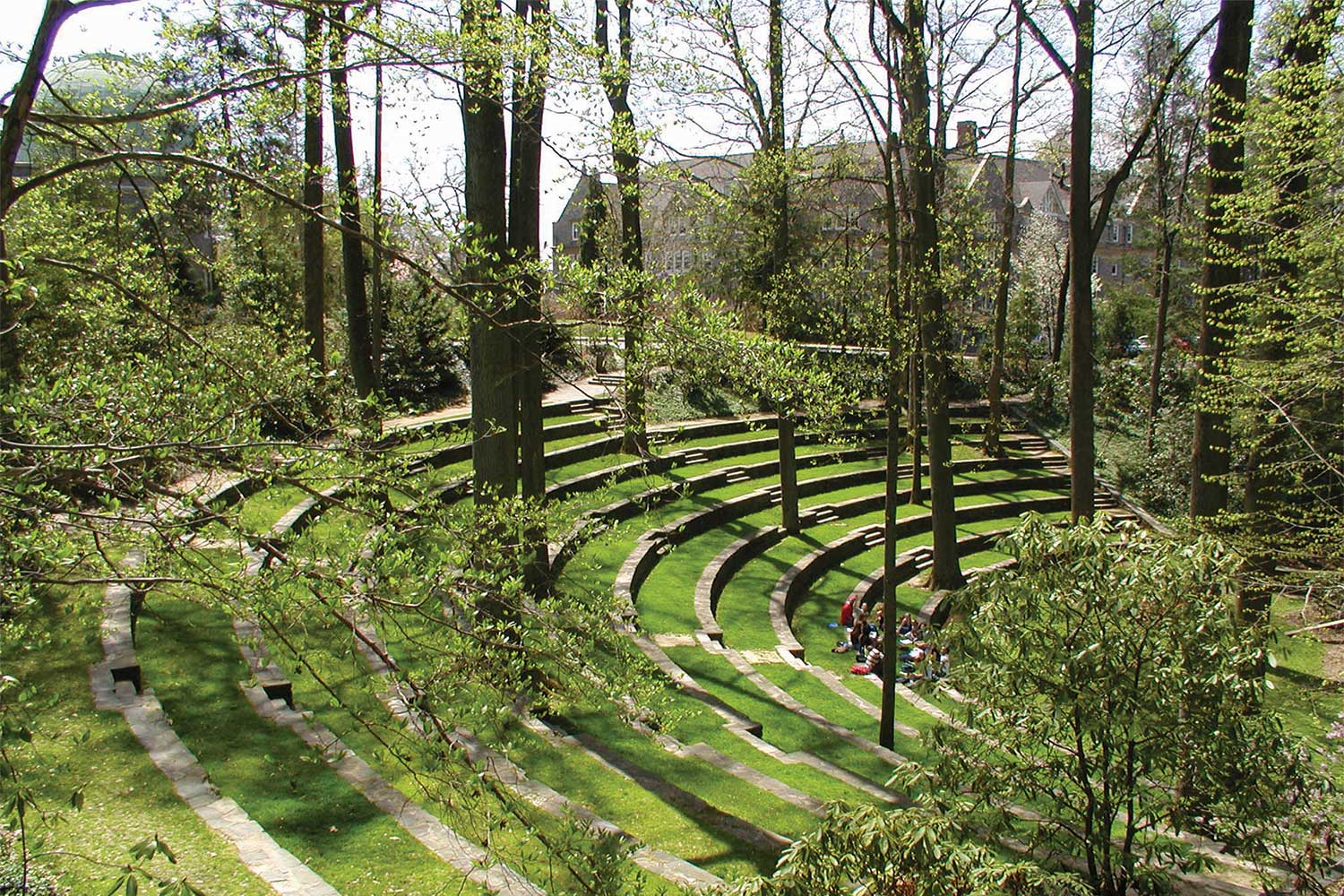
In the spirit of the College’s founders, who emphasized the practical application of knowledge for the common good, Swarthmore students strive to make the most of their opportunities and abilities. They create technology that enables people to track food donations. They design and build structures for reflection and contemplation. They work to initiate positive change. It all begins at the candle-lighting ceremony during First Collection (unless a worldwide pandemic gets in the way, in which case we will make other candle-related plans).
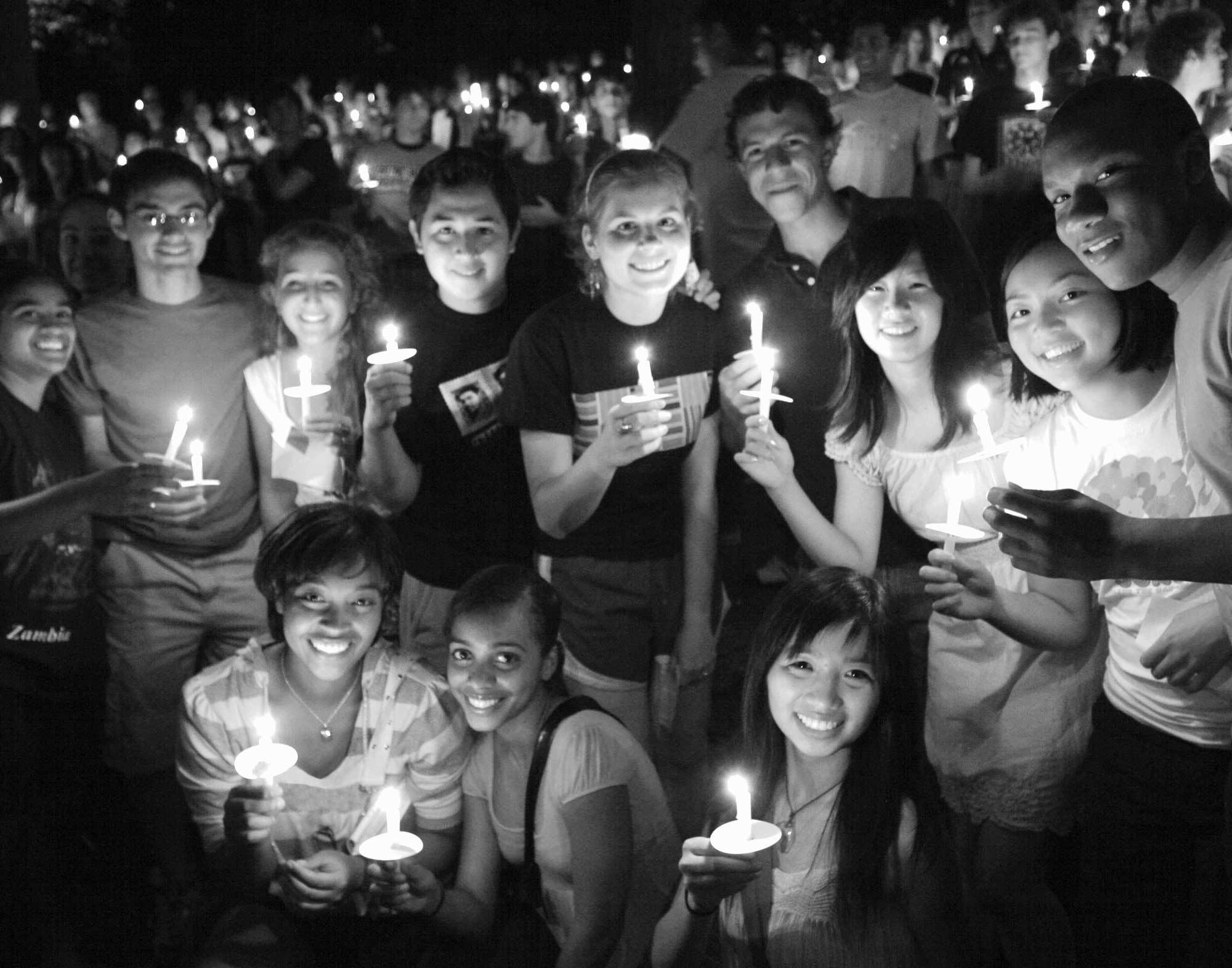
your
vision.
Or maybe you’ll receive a grant for a virtual internship with a nonprofit and surprise yourself at how many hats you can wear — simultaneously. (How many hats do you have, anyway?) Or volunteer in a program that connects you with an adult or child with physical disabilities, redefining the way you see your own abilities. (More examples on p. 80.) Prepare to insert yourself into the real world in whatever ways are possible. Act, reflect, and process; change, improve, and act some more. And don’t forget to enjoy the journey.
your
vision.
Or maybe you’ll receive a grant for a virtual internship with a nonprofit and surprise yourself at how many hats you can wear — simultaneously. (How many hats do you have, anyway?) Or volunteer in a program that connects you with an adult or child with physical disabilities, redefining the way you see your own abilities. (More examples on p. 80.) Prepare to insert yourself into the real world in whatever ways are possible. Act, reflect, and process; change, improve, and act some more. And don’t forget to enjoy the journey.

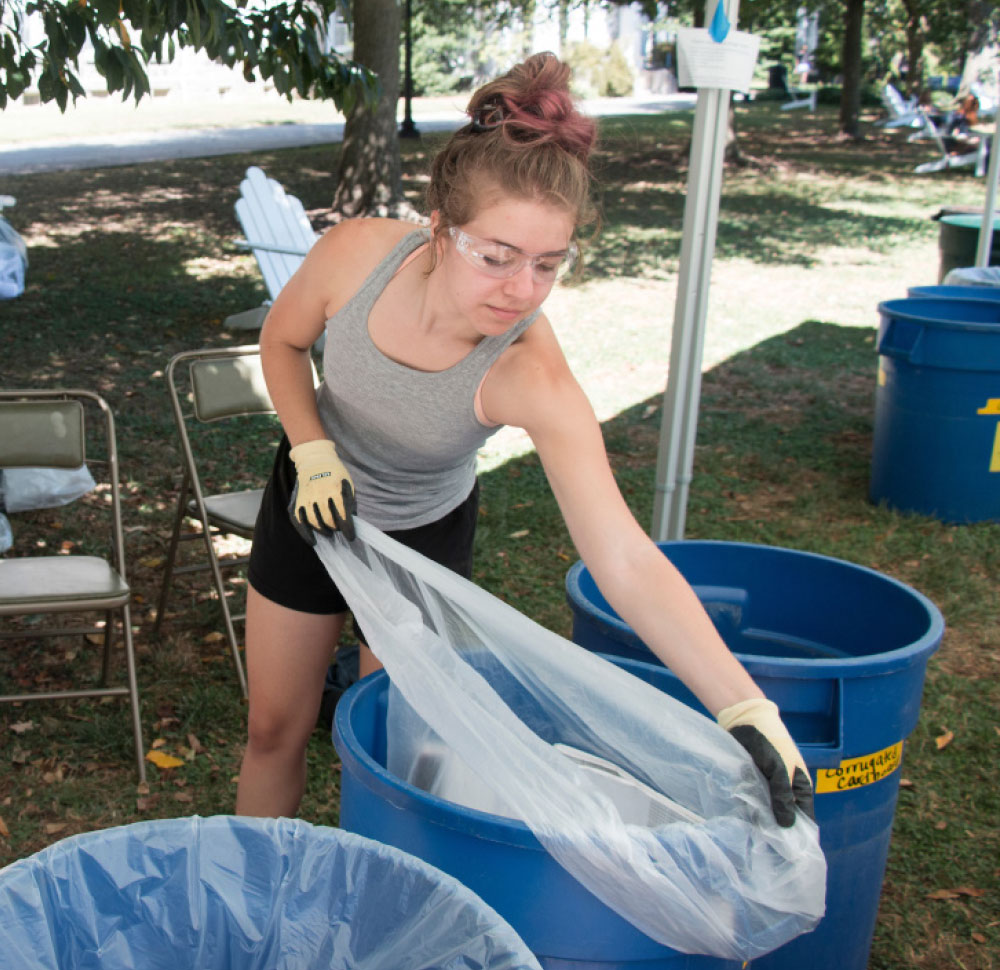
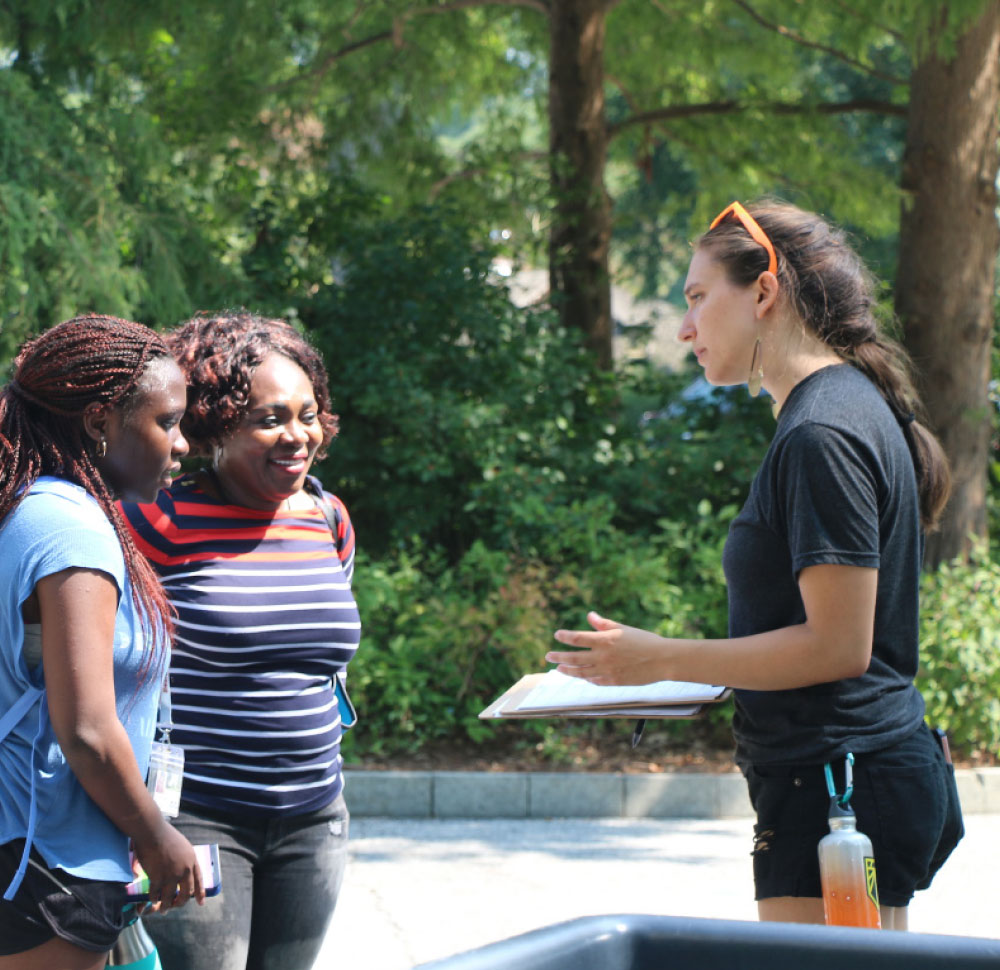
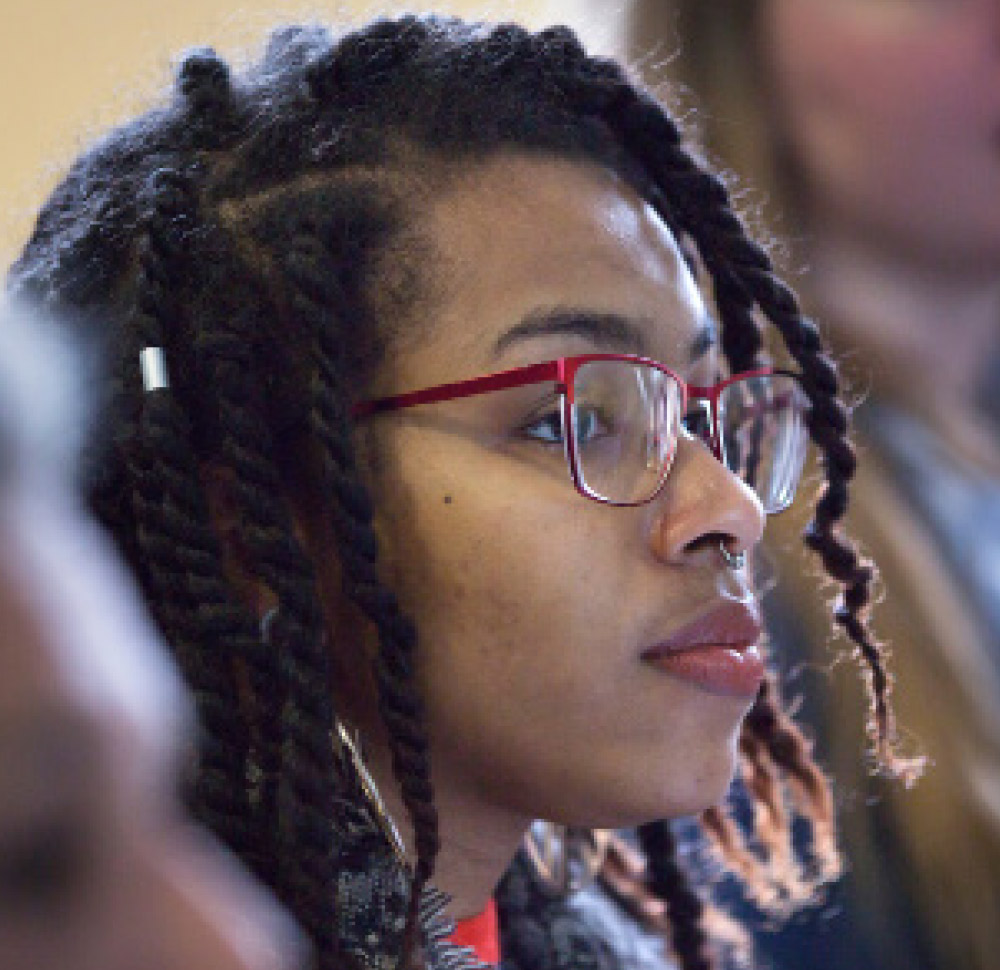

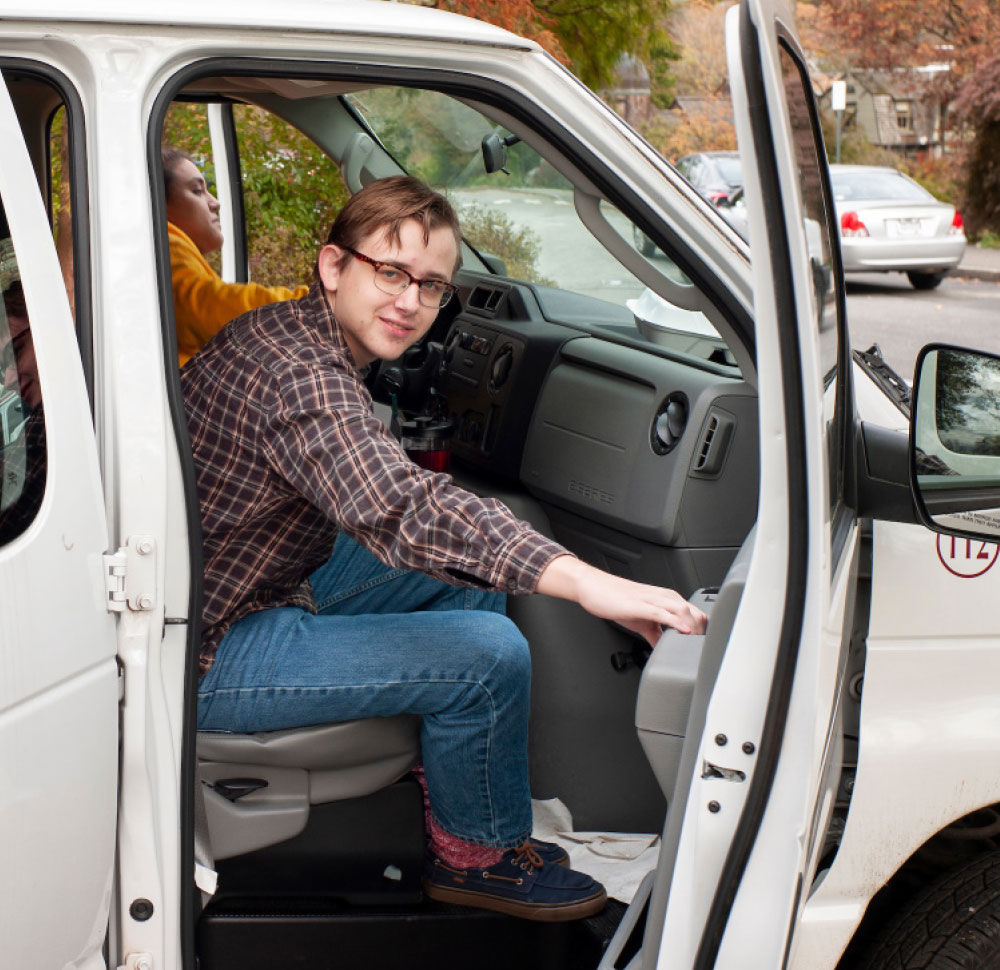






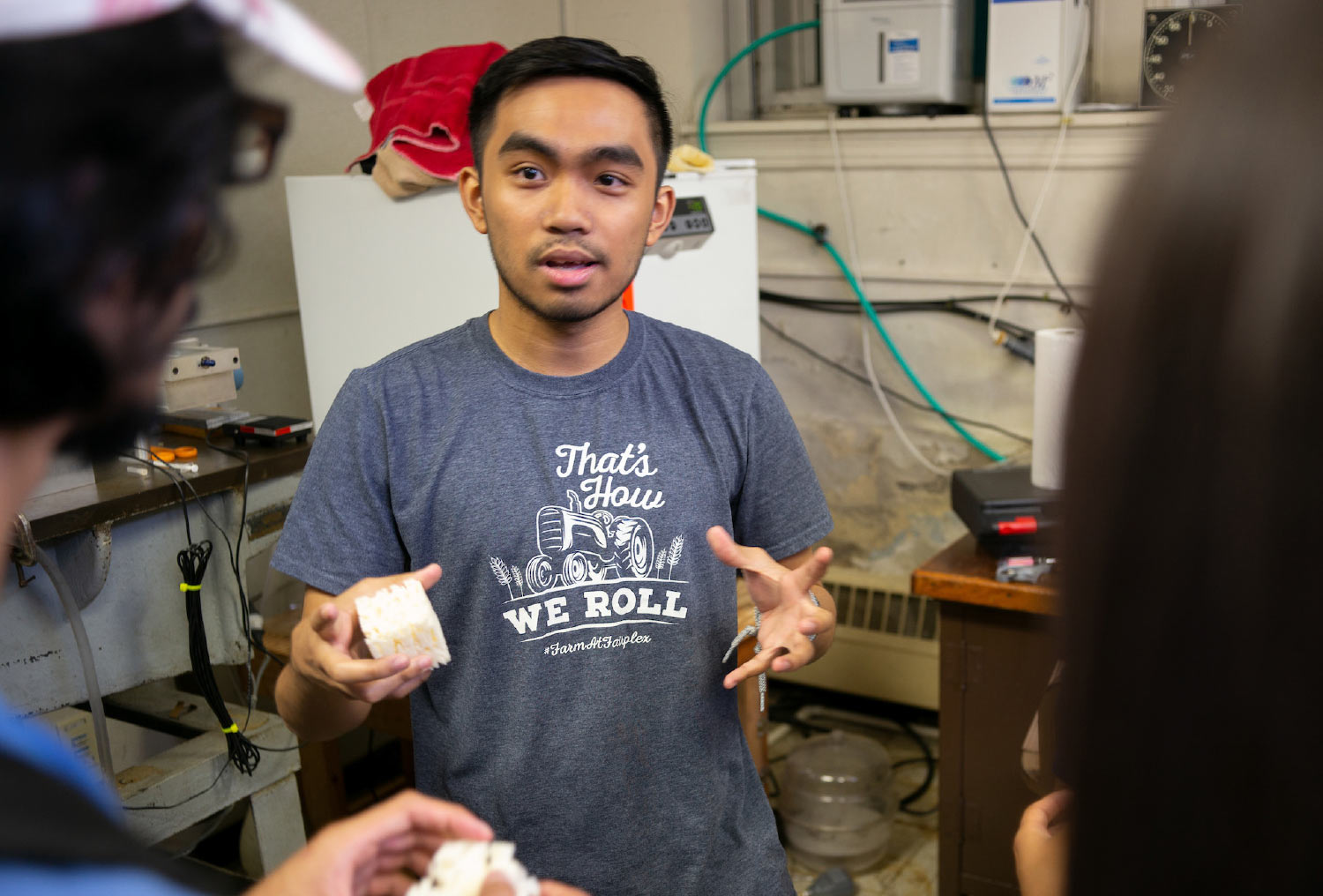






BACK.
At Swarthmore, you can’t compartmentalize academic and social life — and you won’t want to. You’ll socialize in study areas (even virtual ones!) and study in your living space. You’ll commiserate with friends about how busy you all are, and then you’ll join another student group. And when it’s time to graduate, you’ll probably say you learned at least as much outside of class meetings as in them.
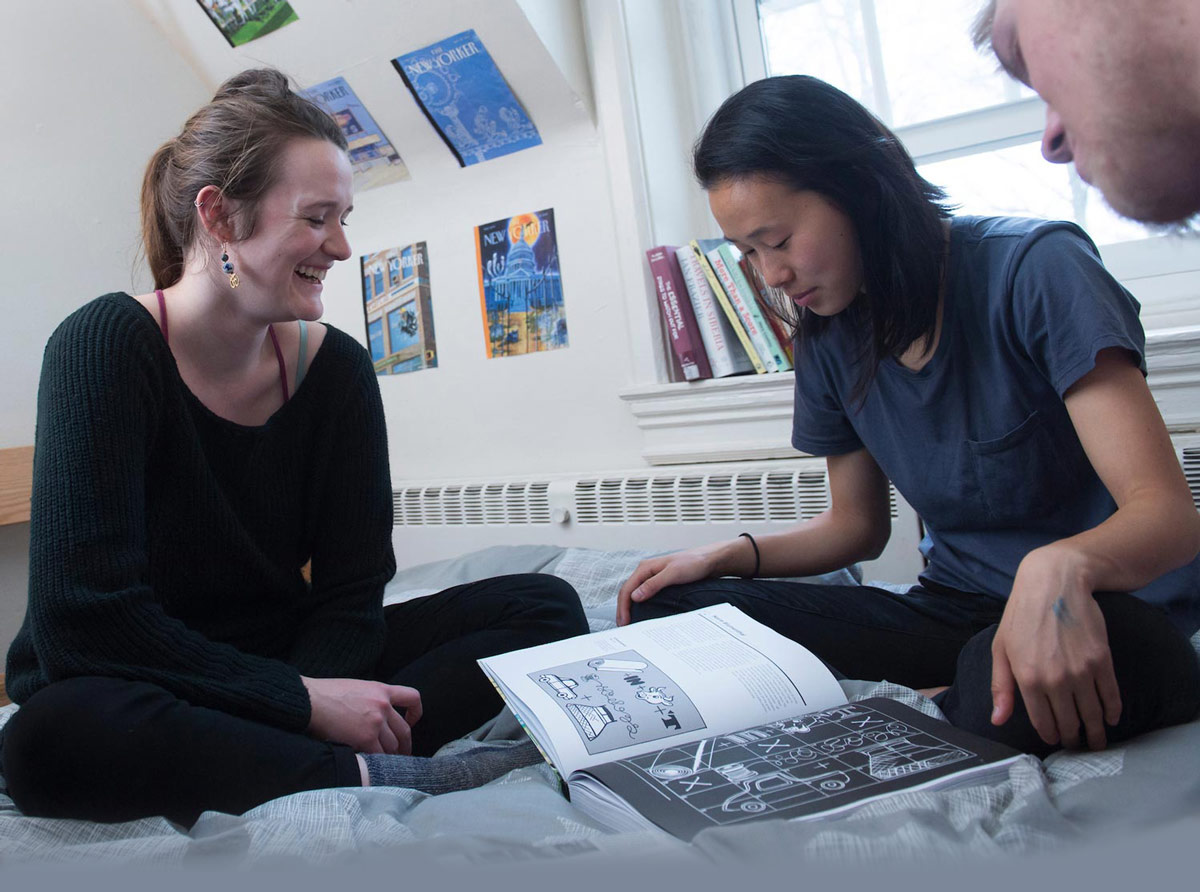
BACK.
At Swarthmore, you can’t compartmentalize academic and social life — and you won’t want to. You’ll socialize in study areas (even virtual ones!) and study in your living space. You’ll commiserate with friends about how busy you all are, and then you’ll join another student group. And when it’s time to graduate, you’ll probably say you learned at least as much outside of class meetings as in them.
THE PHOENIX NEWS paper • film society
• mock trial • KNIT-WITS • BRIDGE CLUB


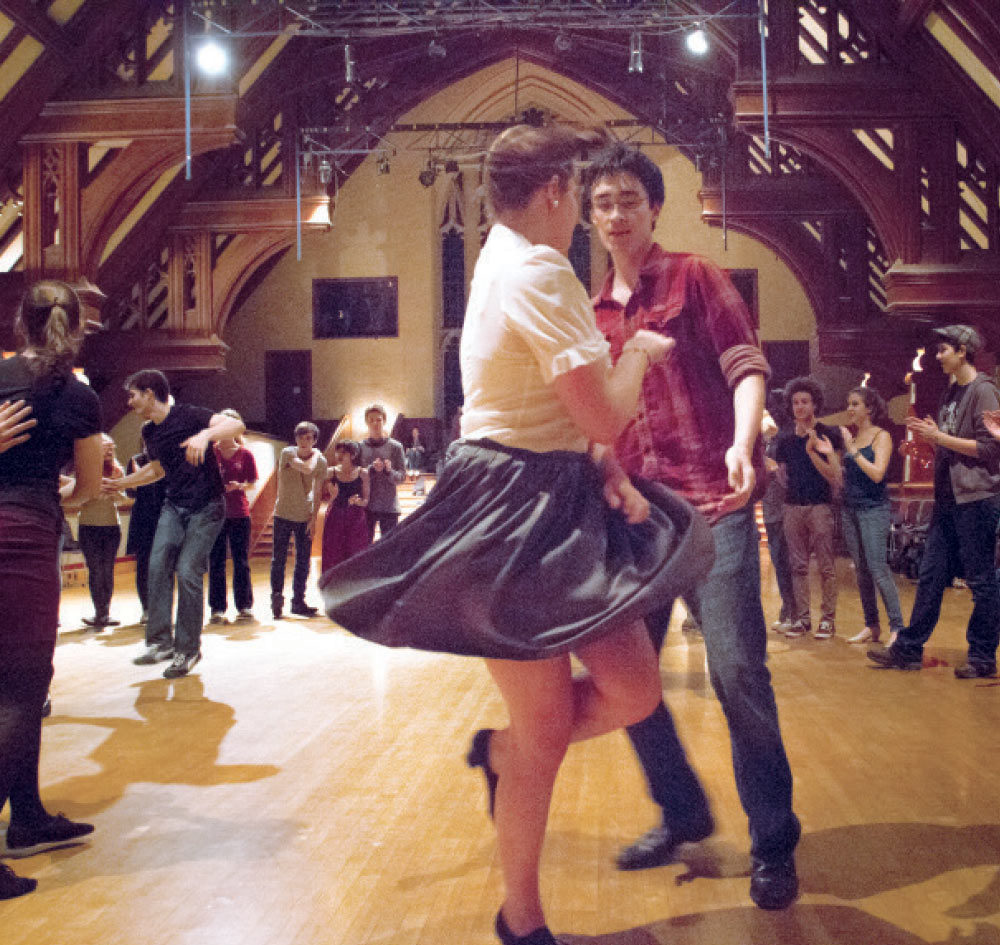
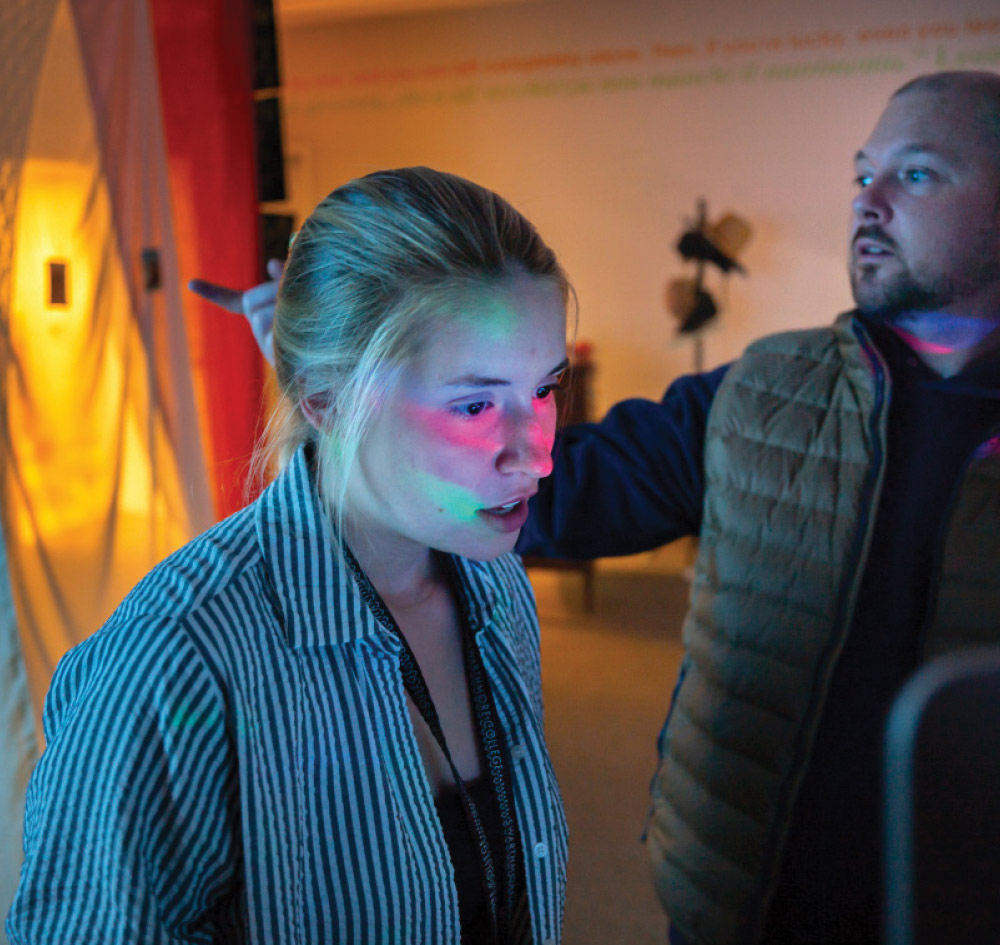
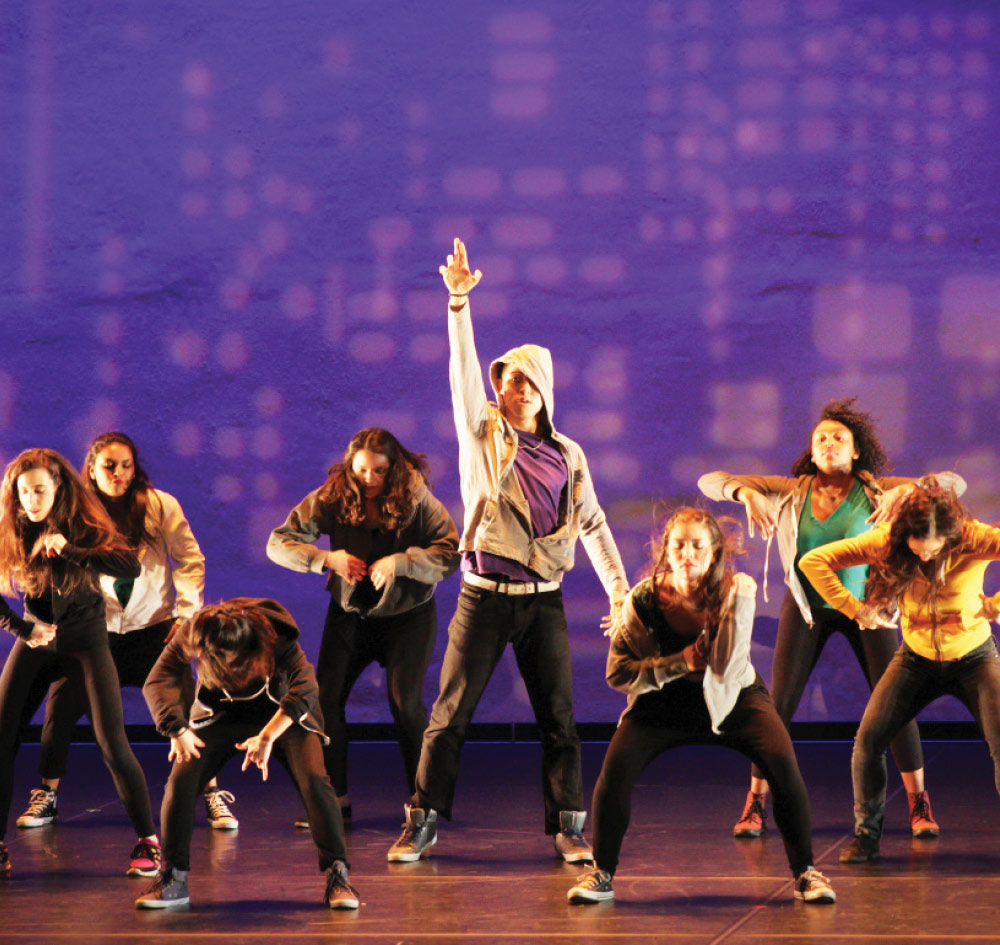
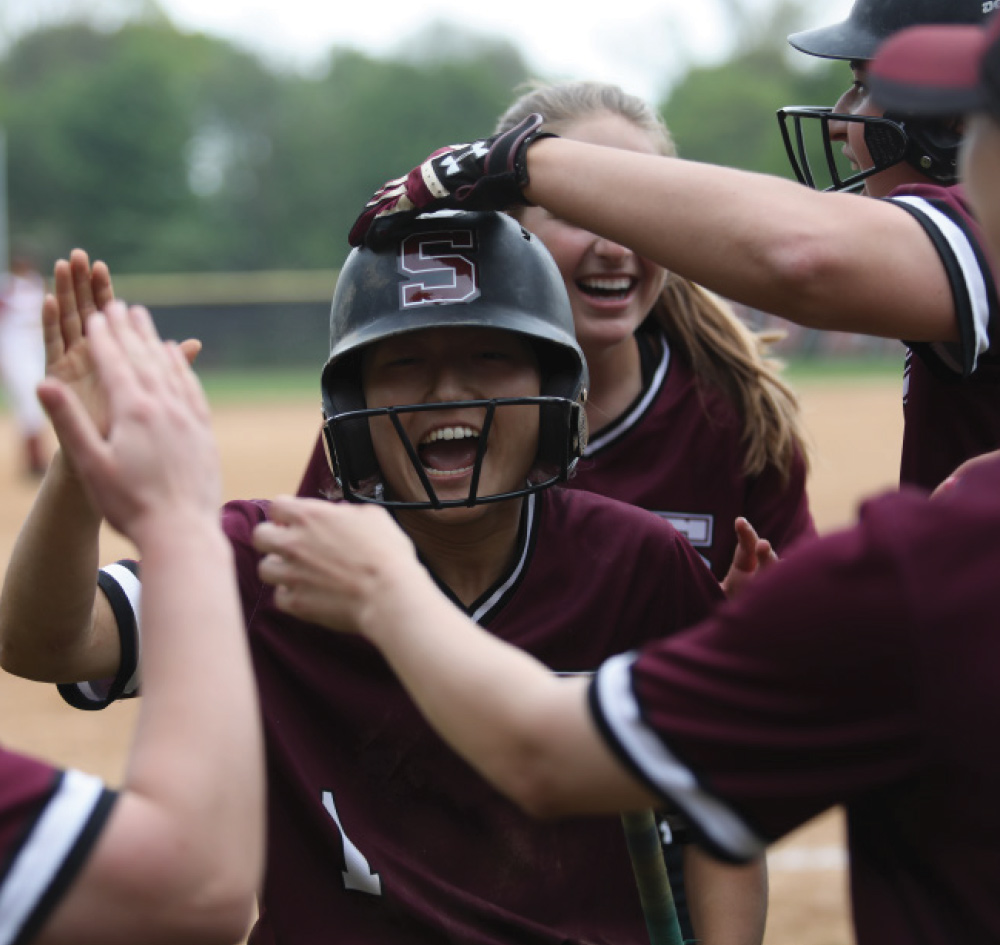
CHOIR • FORUM FOR free speech • DRAMA
board • russian club • swarthmore
business association • WSRN RADIO
GLOBAL NEIGHBORS • VERTIGO-GO improv
comedy • women’s rugby club teams
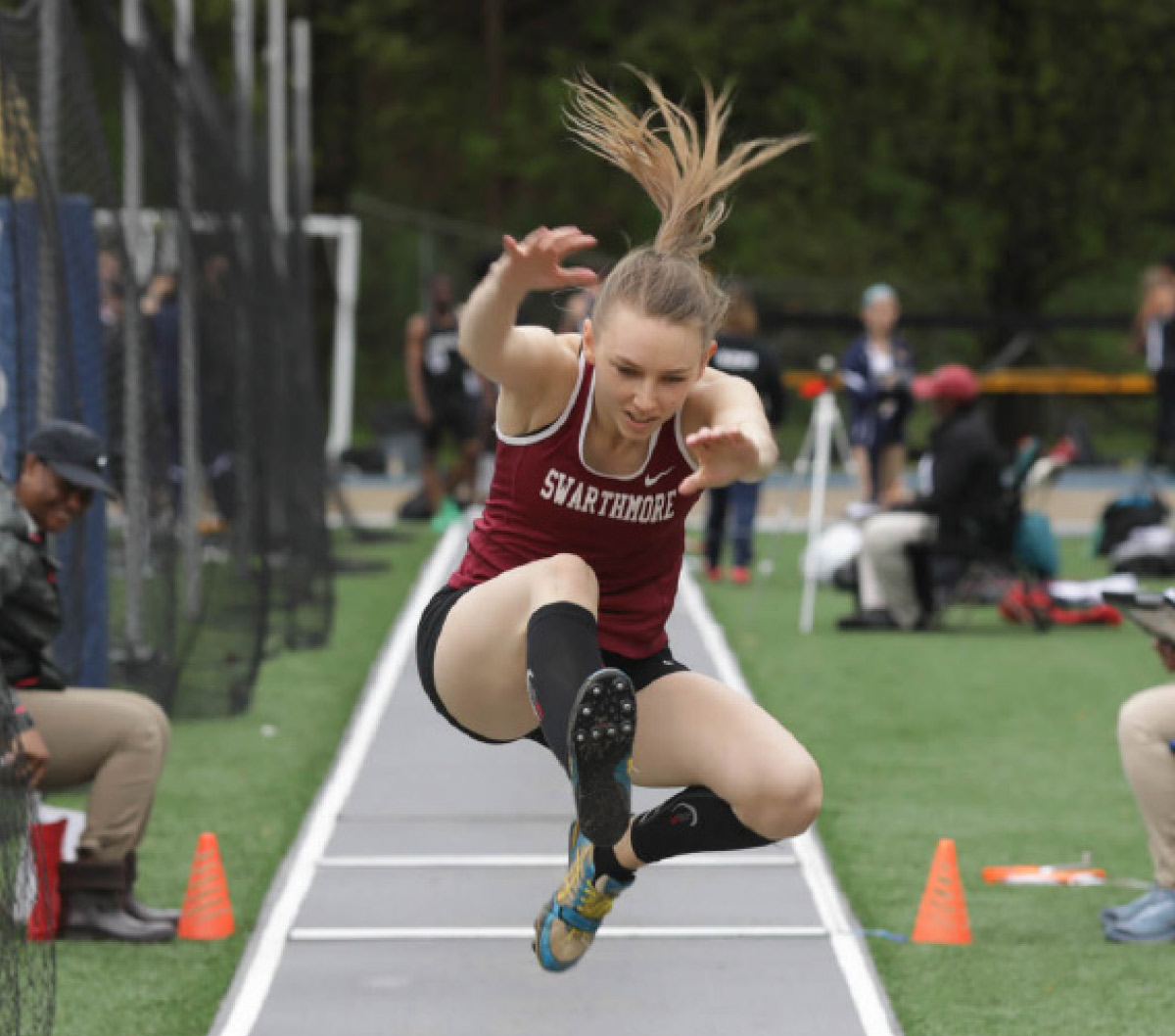

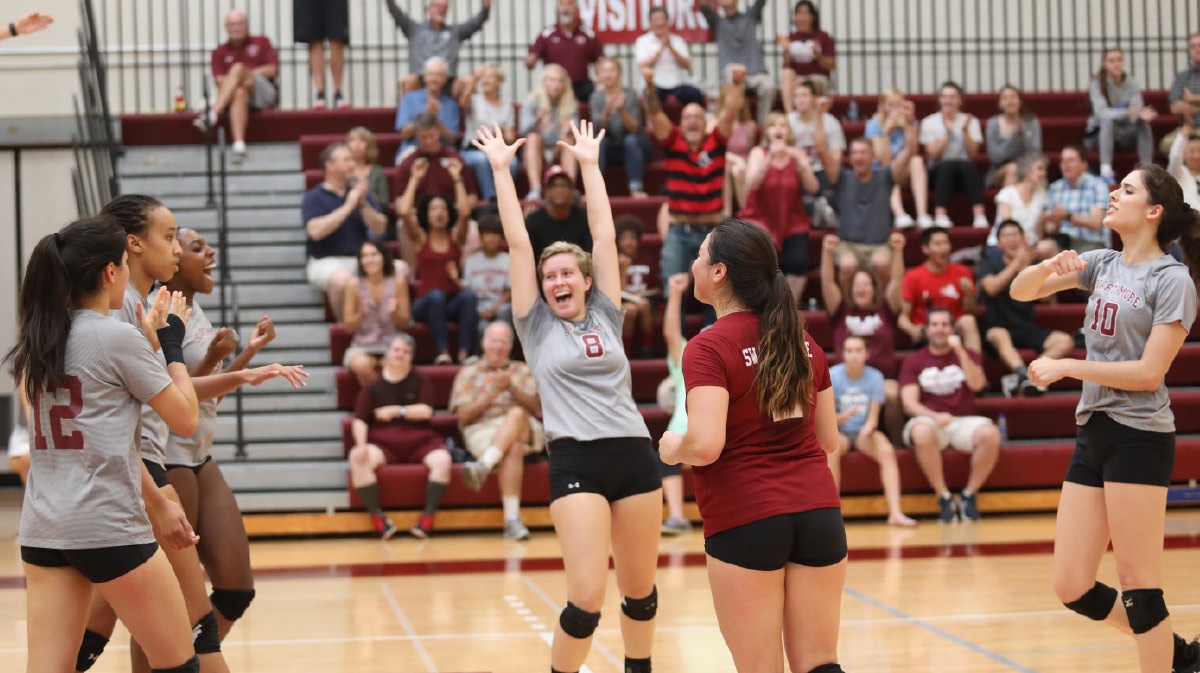

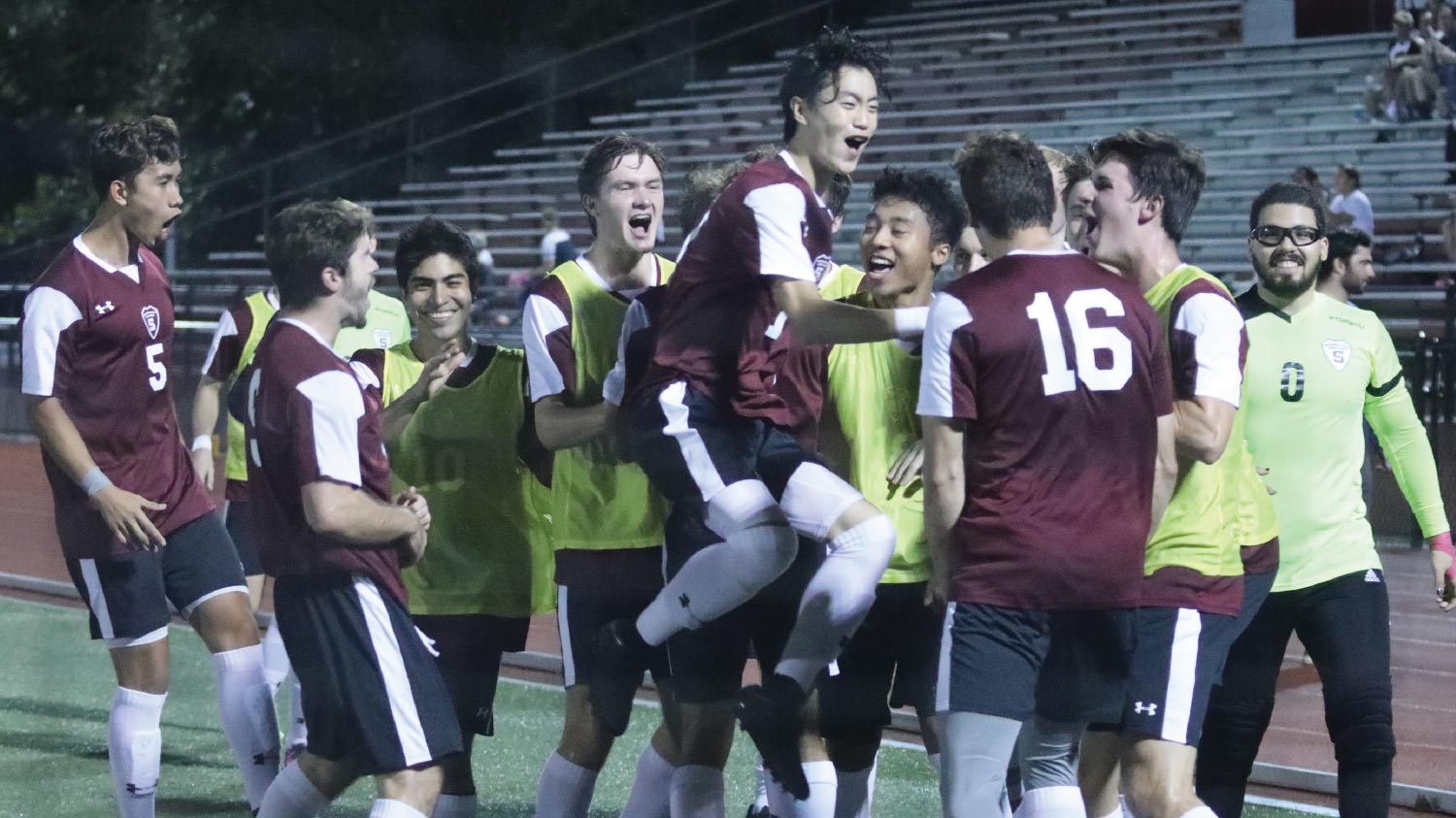
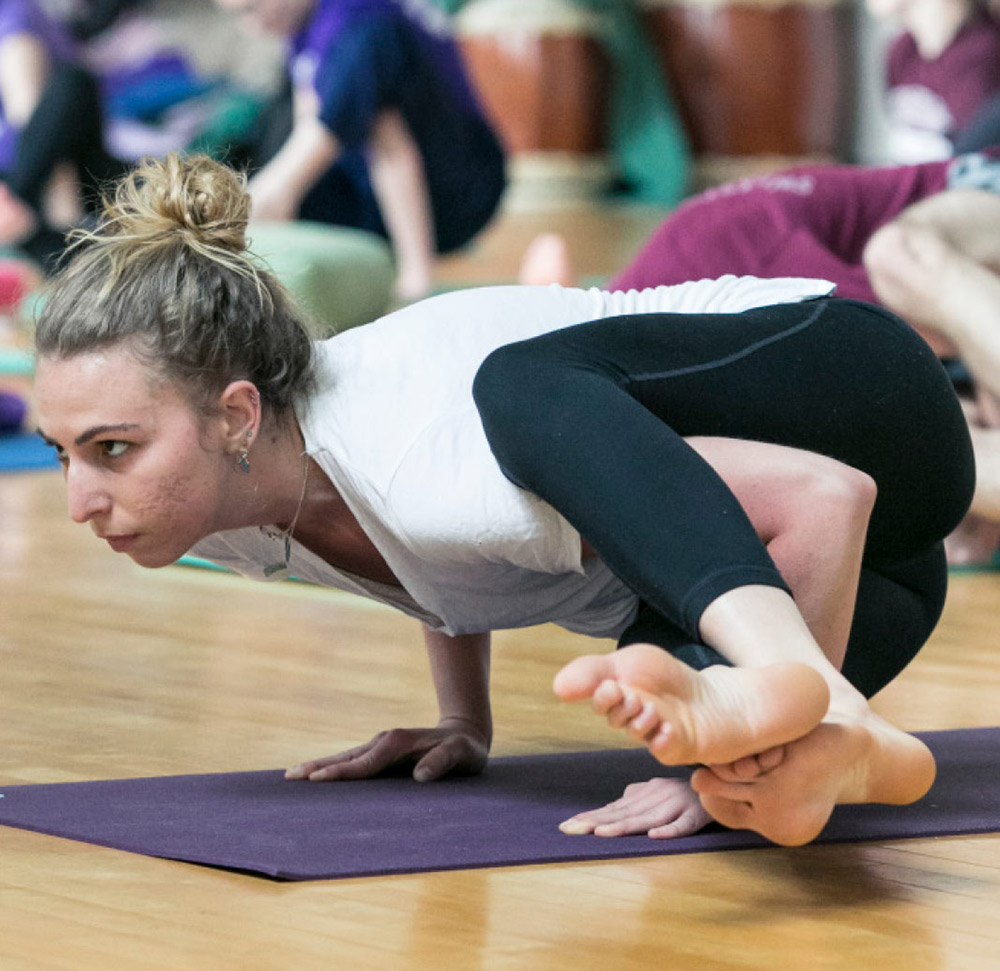

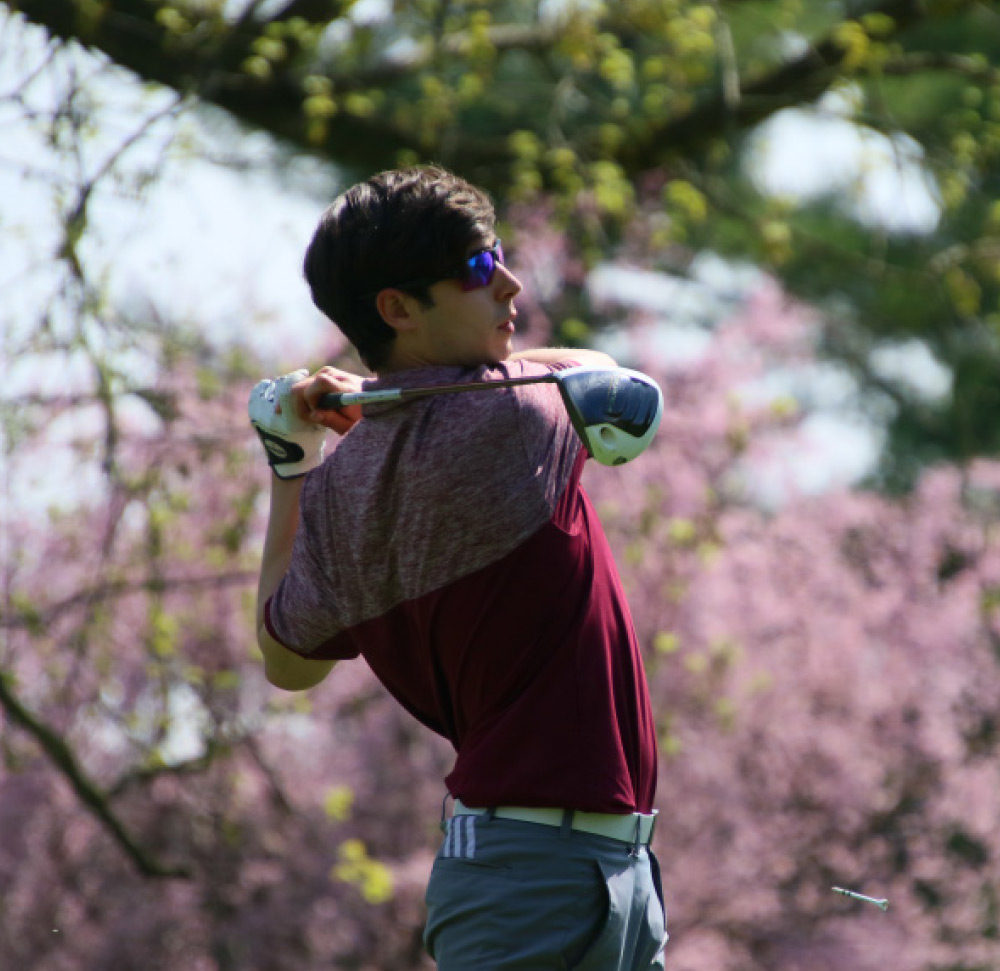
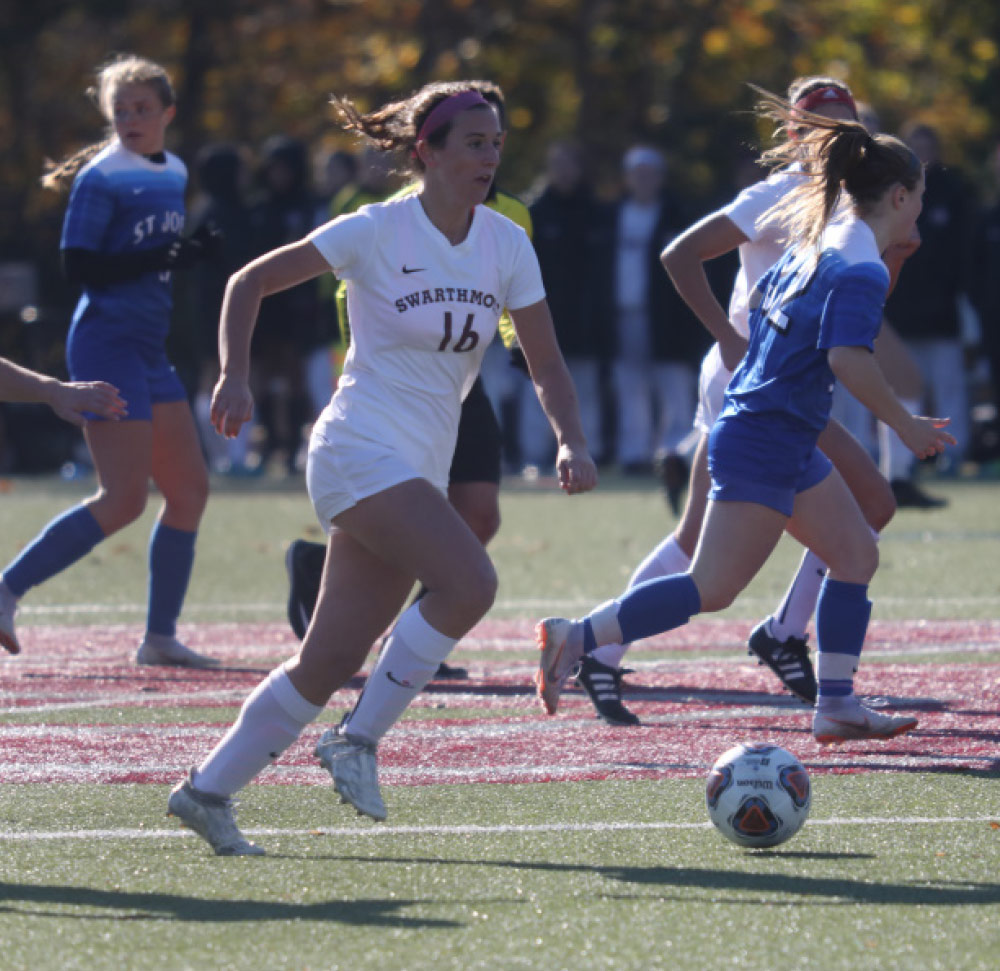






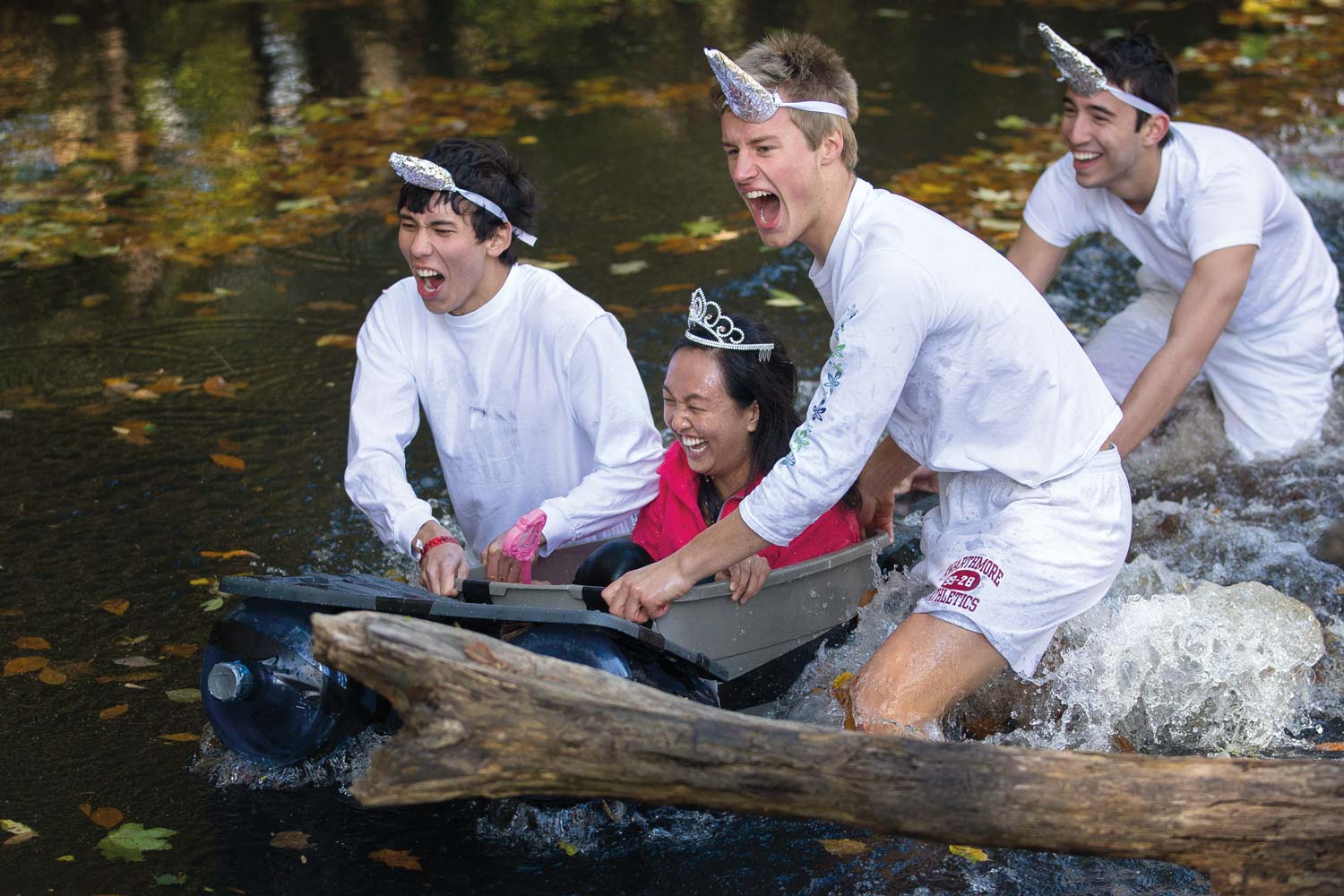
Whether they gather in the Scott Amphitheater or in a digital space, Swarthmore students evolve in ways they can’t predict — forming bonds that deepen throughout their lives.
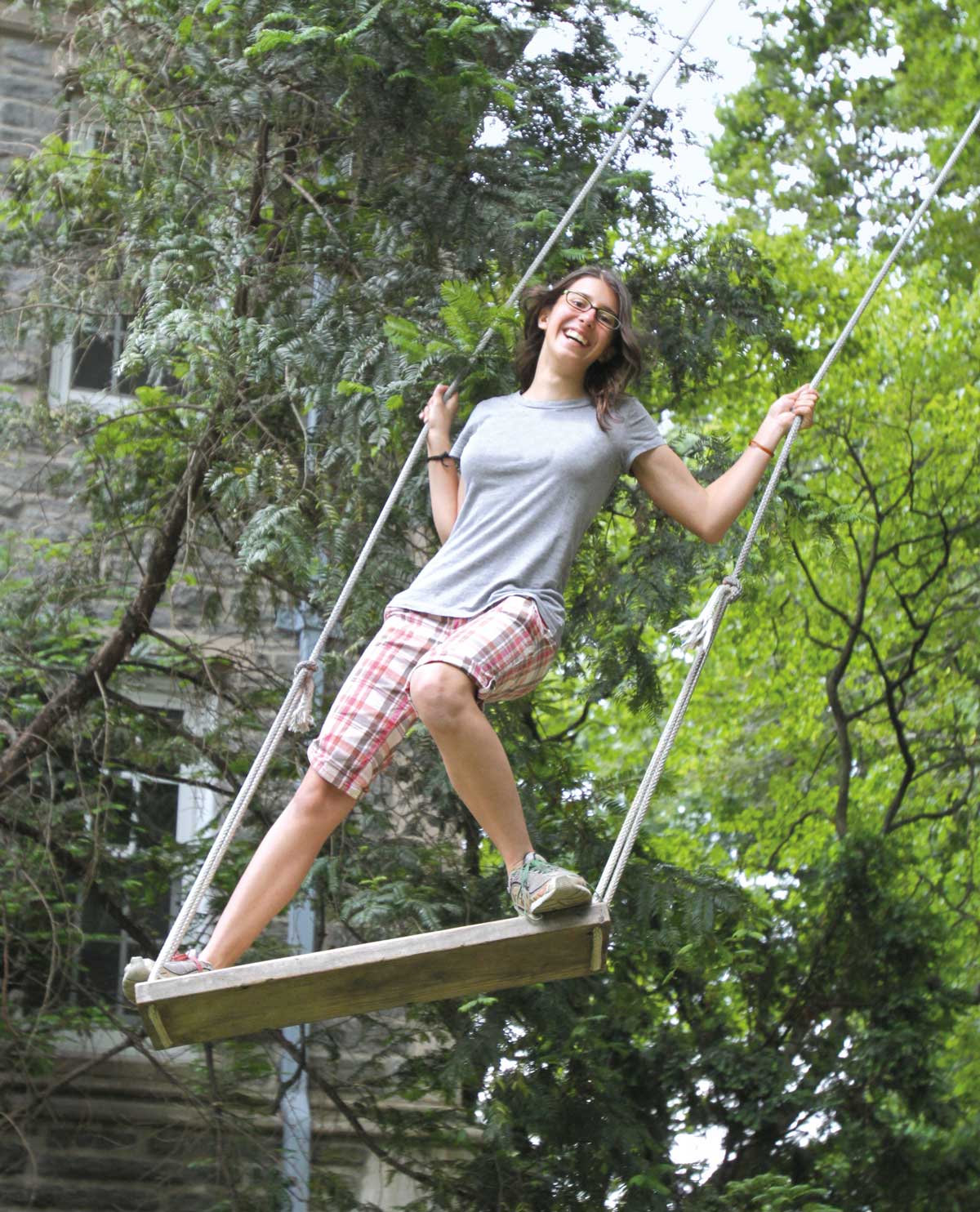
Beyond.
African Leadership Academy (Johannesburg, South Africa) | BlackRock (New York, N.Y.) | Brookings Institution (Washington, D.C.) | Christie’s (New York, N.Y.) | Creative Artists Agency (Los Angeles, Calif.) | Cyclotron Institute (College Station, Texas) | Eastspring Investments (Seoul, South Korea) | Google (Mountain View, Calif.) | International Center of Photography (New York, N.Y.) | London Academy of Music and Dramatic Art (London, England) | Max Planck Institute for Biology of Ageing (Cologne, Germany) | NASA’s Langley Research Center (Hampton, Va.) | National Institutes of Health (Bethesda, Md.) | Salesforce.com (San Francisco, Calif.) | Smithsonian Tropical Research Institute (Panama City, Panama) | Univision (New York, N.Y.) | U.S. Tax Court (Washington, D.C.)
The path from the beauty and tranquility of Swarthmore’s campus to the adventure and opportunity of the wider world is far shorter than you might think. Each fall, the iconic film The Graduate is screened on the lawn in front of Parrish Hall, and each fall, the film reminds students to contemplate the rest of their lives. Fortunately, as Swatties, the power to make meaningful choices is theirs. Like them, you’ll have internship opportunities that either point to career possibilities or lead you away from that thing you always thought you wanted to do.
With Philadelphia less than 30 minutes away and a train station right on campus, life-shaping experiences are within easy reach. On or off campus, internships can be instrumental — such as with the student who, partly on the strength of helping to build a database of Crum Woods ecological data, was offered a position at Google. The bottom line: Swarthmore prepares you for anything and everything. From biomedical researchers to software company presidents and founders of nonprofits, our alumni are equipped to make the most of where they’ve been — and make sense of what they haven’t yet seen.
Swarthmore
Students who graduated in Swarthmore’s Class of 2020 entered the following fields in their first jobs after graduation:
- Finance & Consulting
- Technology/ Engineering
- Research
- Law
- Public Service
- Education
Employers of recent Swarthmore graduates:
- Amazon.com
- Apple, Inc.
- Bank of America Merrill Lynch
- Booz Allen Hamilton
- Brookings Institution
- Capital One
- Center for Applied Linguistics
- Comcast
- Dana-Farber Cancer Institute
- Federal Reserve Bank of New York
- Field Museum of Natural History
- Fine Arts Work Center
- Moody’s Analytics
- Microsoft, Inc.
- Ministry of Education (Singapore)
- National Human Genome Research Institute
- National Public Radio
- Netflix
- Northrop Grumman
- Peace Corps
- Principal Financial Group
- Smithsonian Institution
- Sotheby’s
- Space Telescope Science Institute
- Standard & Poor’s
- U.S. Department of Justice
- U.S. Department of State
- Venmo
- Walnut Street Theatre
- Boston University
- Brown University
- Carnegie Mellon University
- Columbia University
- Duke University
- Georgetown University
- Harvard University
- Icahn School of Medicine at Mount Sinai
- Johns Hopkins University
- Massachusetts Institute of Technology
- New York University
- Northwestern University
- Princeton University
- Stanford University
- University of California, Berkeley
- University of Cambridge
- University of Chicago
- University of Michigan
- University of Oxford
- University of Pennsylvania
- University of Virginia
- Yale University
Swarthmore
Students who graduated in Swarthmore’s Class of 2020 entered the following fields in their first jobs after graduation:
- Finance & Consulting
- Technology/ Engineering
- Research
- Law
- Public Service
- Education
Employers of recent Swarthmore graduates:
- Amazon.com
- Apple, Inc.
- Bank of America Merrill Lynch
- Booz Allen Hamilton
- Brookings Institution
- Capital One
- Center for Applied Linguistics
- Comcast
- Dana-Farber Cancer Institute
- Federal Reserve Bank of New York
- Field Museum of Natural History
- Fine Arts Work Center
- Moody’s Analytics
- Microsoft, Inc.
- Ministry of Education (Singapore)
- National Human Genome Research Institute
- National Public Radio
- Netflix
- Northrop Grumman
- Peace Corps
- Principal Financial Group
- Smithsonian Institution
- Sotheby’s
- Space Telescope Science Institute
- Standard & Poor’s
- U.S. Department of Justice
- U.S. Department of State
- Venmo
- Walnut Street Theatre
- Boston University
- Brown University
- Carnegie Mellon University
- Columbia University
- Duke University
- Georgetown University
- Harvard University
- Icahn School of Medicine at Mount Sinai
- Johns Hopkins University
- Massachusetts Institute of Technology
- New York University
- Northwestern University
- Princeton University
- Stanford University
- University of California, Berkeley
- University of Cambridge
- University of Chicago
- University of Michigan
- University of Oxford
- University of Pennsylvania
- University of Virginia
- Yale University
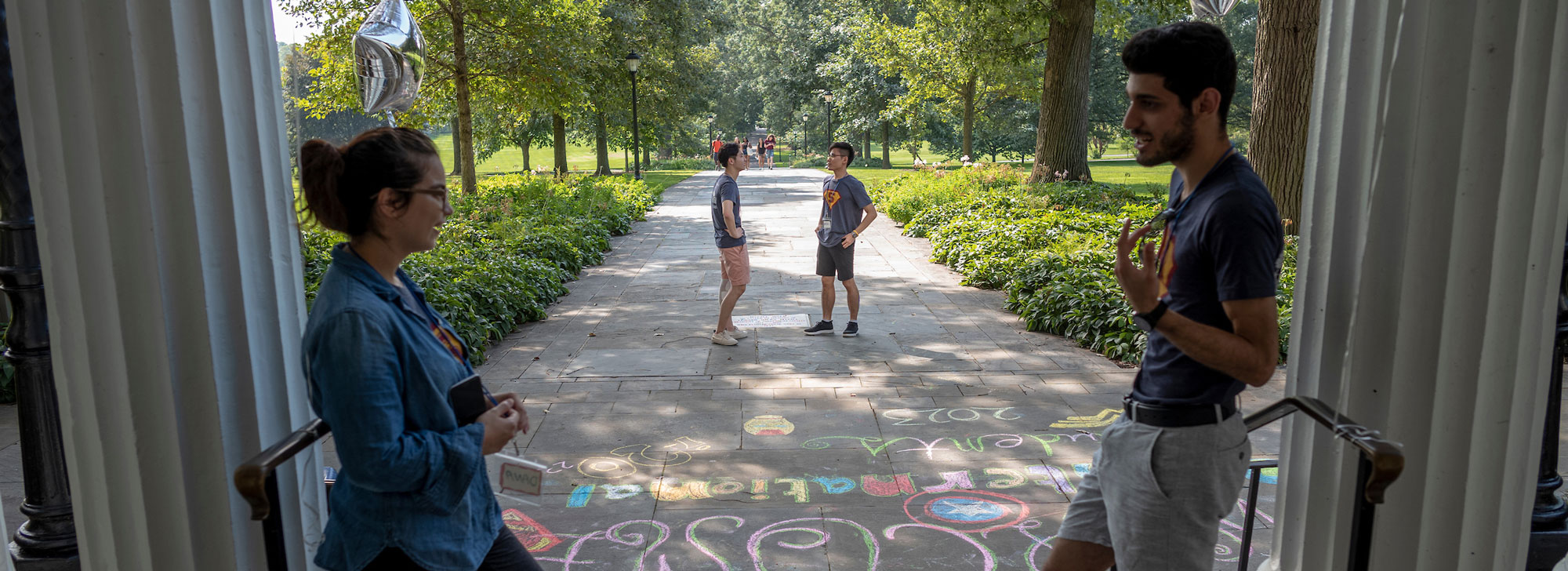
Against my better judgment, I read the whole book. Are you happy?
PLEASED AS PUNCH.
If you play your cards right, I might just apply.
EXCELLENT! NOW . . . BEFORE WE WRAP UP, IS THERE ANYTHING ELSE YOU’D LIKE TO KNOW?
The application process is vexing. Might you share some insider tips?
WE THOUGHT YOU’D NEVER ASK. Where shall we start?
How about the essay? Is it basically there to make me suffer?
NOT AT ALL! (At least we hope it doesn’t.) IT IS THE BEST PLACE FOR YOU TO SHOW US WHO YOU REALLY ARE underneath all the grades and courses and such — not just your accomplishments, but what you value, what you’ve learned from your mistakes, how you’ve grown.
This is good stuff. What else?
Make sure your recommendations are written by the teachers who really know you and how you think — not just the ones who gave you the best grades.
Makes sense. Do continue.
Take the most challenging course of study you think you can manage. Apply to a range of places with varying levels of selectivity. And don’t take this process personally. However it turns out, you’ll find a great place to land.
Aww, thanks. Are you just trying to butter me up?
MAYBE JUST A LITTLE.
I appreciate it.
YOU’RE WELCOME.


LIBERAL
ARTS
education

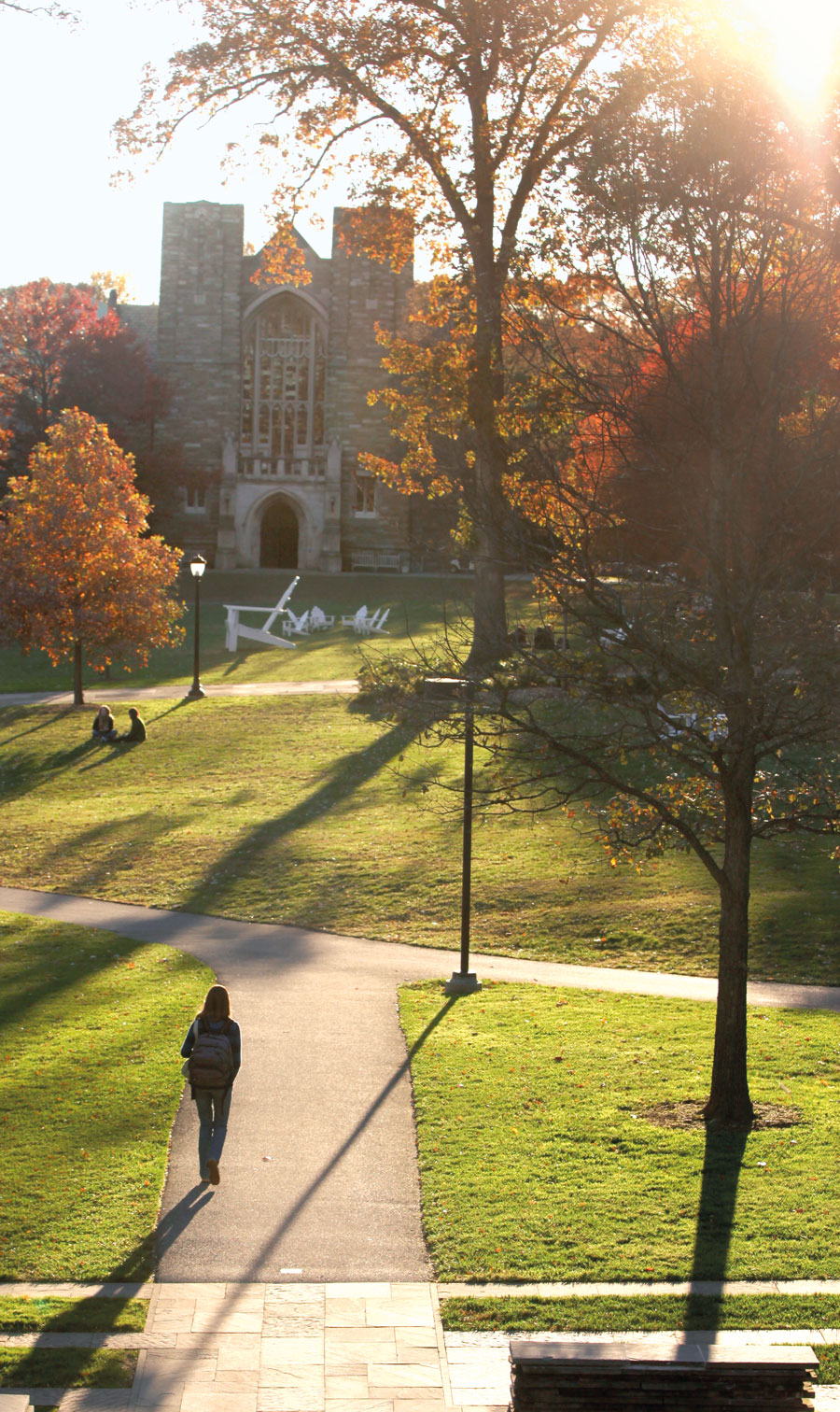
stunningly
beautiful
acres
majors
and
programs
- Ancient History
- Anthropology
- Arabic
- Art
- Art History
- Asian Studies
- Astronomy
- Biochemistry
- Biology
- Black Studies
- Chemistry
- Chinese
- Classics
- Cognitive Science
- Comparative Literature
- Computer Science
- Dance
- Design Your Own Major
- Economics
- Educational Studies
- Engineering
- English Literature
- Environmental Studies
- Film & Media Studies
- French & Francophone Studies
- Gender & Sexuality Studies
- German Studies
- Global Studies
- Greek
- History
- Interpretation Theory
- Islamic Studies
- Japanese
- Latin
- Latin American & Latino Studies
- Linguistics
- Mathematics
- Medieval Studies
- Modern Languages & Literatures
- Music
- Peace & Conflict Studies
- Philosophy
- Physics
- Political Science
- Psychology
- Religion
- Russian
- Sociology
- Spanish
- Statistics
- Theater

accessible
faculty
CAMPUS COMMUNITY
In 2019-2020, the College’s 1,667 undergraduates came from 49 states and 78 countries. Their racial/ethnic distribution was:
- African American
- American Indian/Native Alaskan
- Asian
- Hispanic
- International/ Undocumented
- Native Hawaiian/Other Pacific Islander
- Race/ethnicity unreported
- Two or more races
- White
Honors
Program


pass/fail
semester
research
opportunities

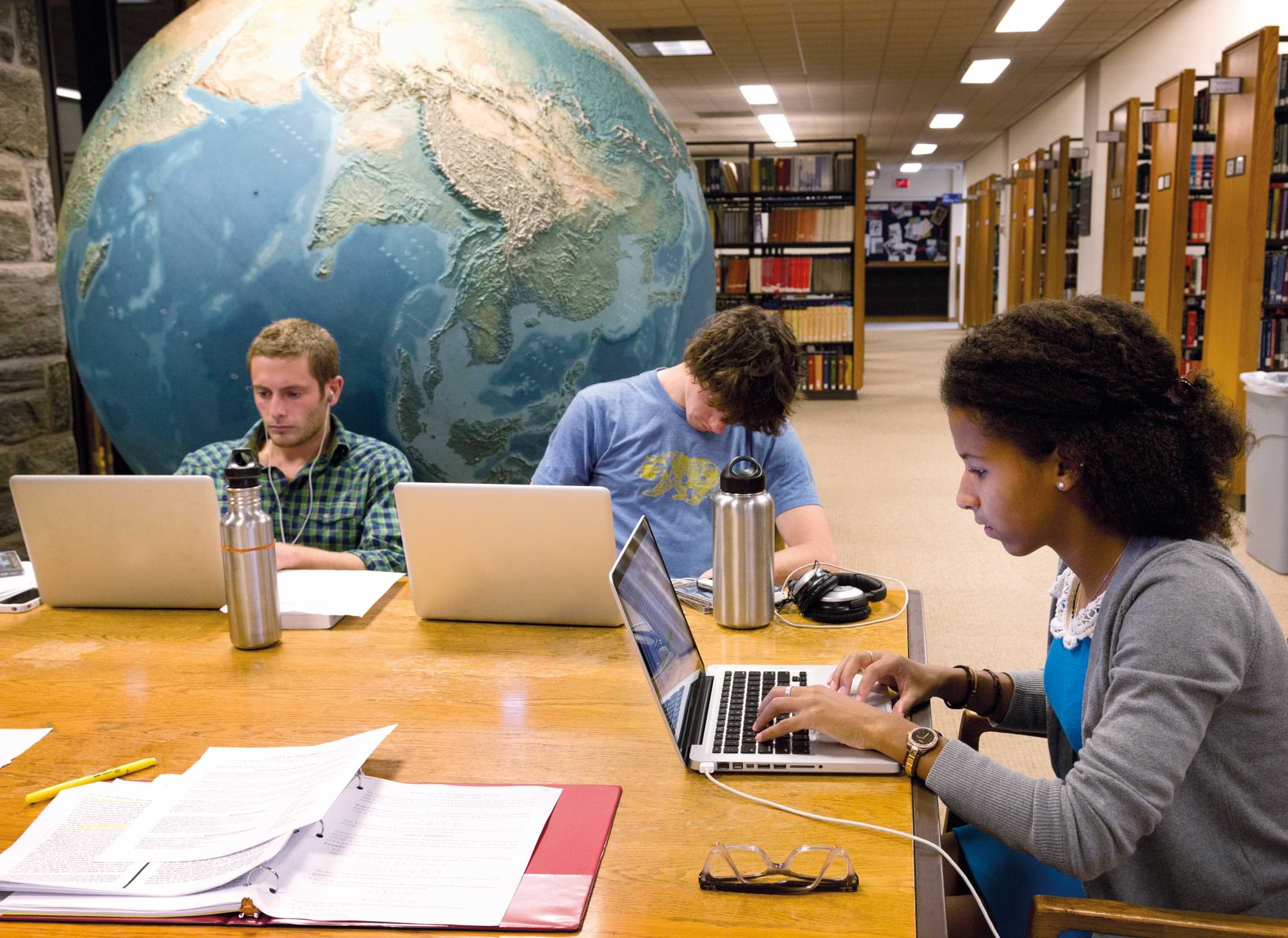
academic
support
- Computer Science Student Mentors (“Ninjas”)
- Dean’s Tutor Program (individual and group sessions for students with demonstrated academic need)
- Engineering Academic Support (“Wizards” group study sessions)
- Laboratory Teaching Assistants
- Math & Stat Academic Support (“Pi-rates” and “Mu-ses”)
- Office of Learning Resources (time-management and test-taking workshops)
- Science Associates Program (collaborative problem solving)
- Student Academic Mentors
- Student Disability Services (accommodations to ensure full access and participation)
- Writing Center (staffed by trained Writing Associates and Speaking Associates, who help peers improve their writing and public speaking skills)
clubs,
and activities
Swarthmore provides resources for programs, initiatives, and more than 100 student-run clubs to support a diverse campus, such as:
- ABLLE (Achieving Black and Latino Leaders of Excellence)
- AMENA (Arab, Middle Eastern, North African students)
- Black Cultural Center
- COLORS (queer, trans, and questioning students of color)
- Deshi (South Asian cultural group)
- Drama Board
- ENLACE (LatinX students)
- First-Gen and Low-Income Students Council
- HAN (Korean students)
- HAPA (multiracial students with Asian ancestry)
- i20 (International Students Organization)
- Intercultural Center
- Interfaith Center
- International Student Center
- Kizuna (Japanese Cultural Appreciation Club)
- Multi (students of multicultural identities)
- Muslim Students Association
- Newman Catholic Campus Ministry
- Organizing to Redefine Asian Activism
- The Phoenix (newspaper)
- QuestBridge Scholars
- Small Craft Warnings (literary magazine)
- Southeast Asian Student Association
- Students of Caribbean Ancestry
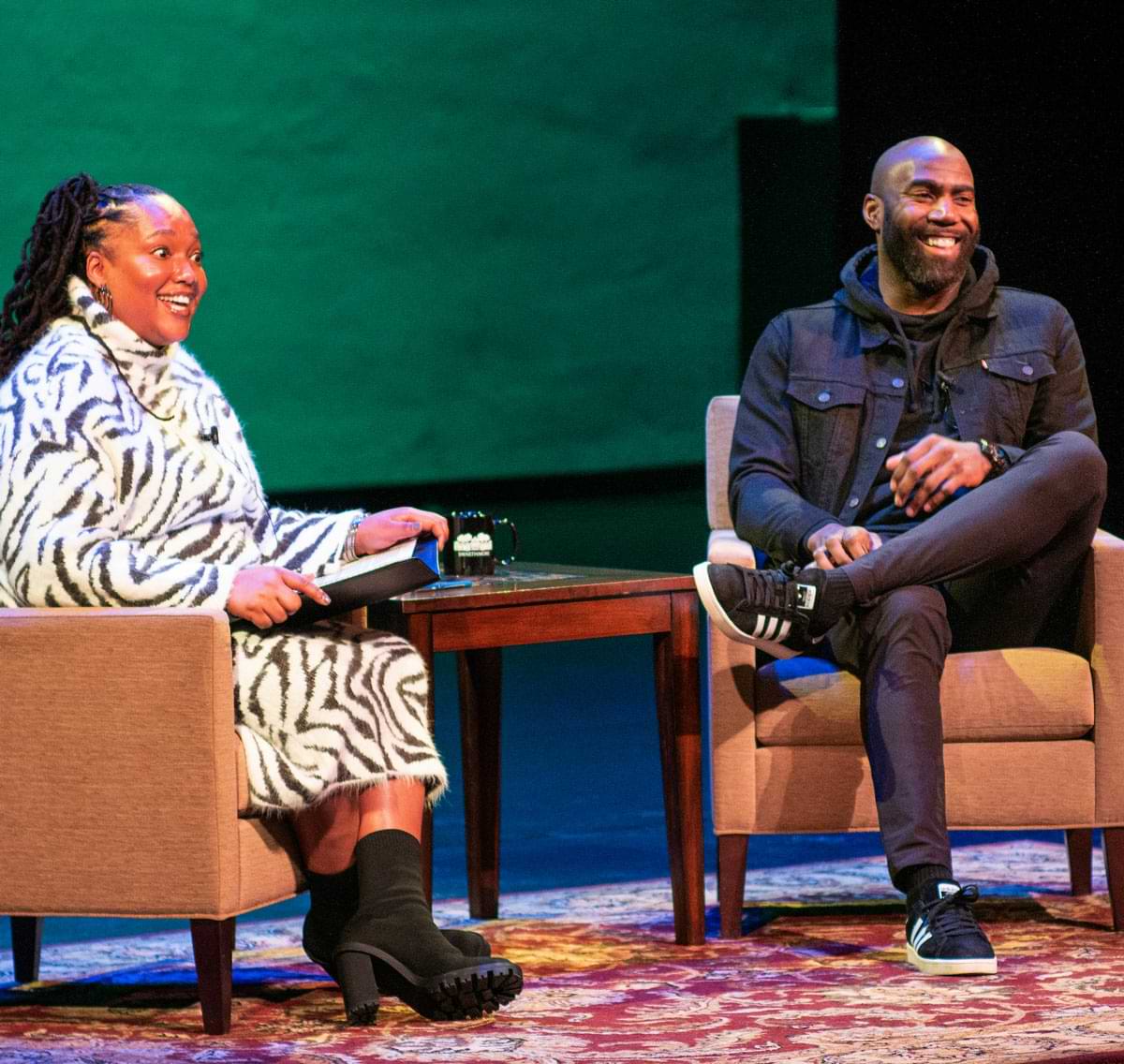
- Swarthmore African Student Association
- Swarthmore African-American Student Society
- Swarthmore College Young Democrats
- Swarthmore Conservative Society
- Swarthmore Indigenous Students Association
- Swarthmore Kehilah: Jewish Community
- Swarthmore Progressive Christians
- Swarthmore Quaker Society
- Swarthmore Queer Union
- Swarthmore Zero Waste
- Tech for Social Good
- Women’s Resource Center
- WOCKA (Women of Color Kick Ass)
Recent speakers, performers, and visiting artists included noted authors Nikki Giovanni and Patricia Park ’03, justice advocate Bryan Stevenson, Broadway actress Renée Elise Goldsberry, global statesman David Miliband, visual artist Njideka Akunyili Crosby ’04, punk-rock art collective Pussy Riot, athlete and entrepreneur Malcolm Jenkins, and activist and author Sybrina Fulton.
pass/fail
semester
Swarthmore is a member of the NCAA Division III Centennial Conference, and has 22 varsity teams:
Men’s
- Baseball
- Basketball
- Cross Country
- Golf
- Lacrosse
- Soccer
- Swimming
- Tennis
- Track & Field (indoor and outdoor)
Women’s
- Badminton
- Basketball
- Cross Country
- Field Hockey
- Lacrosse
- Soccer
- Softball
- Swimming
- Tennis
- Track & Field (indoor and outdoor)
- Volleyball
Students also participate on eight chartered club teams and in a wide range of intramural sports.
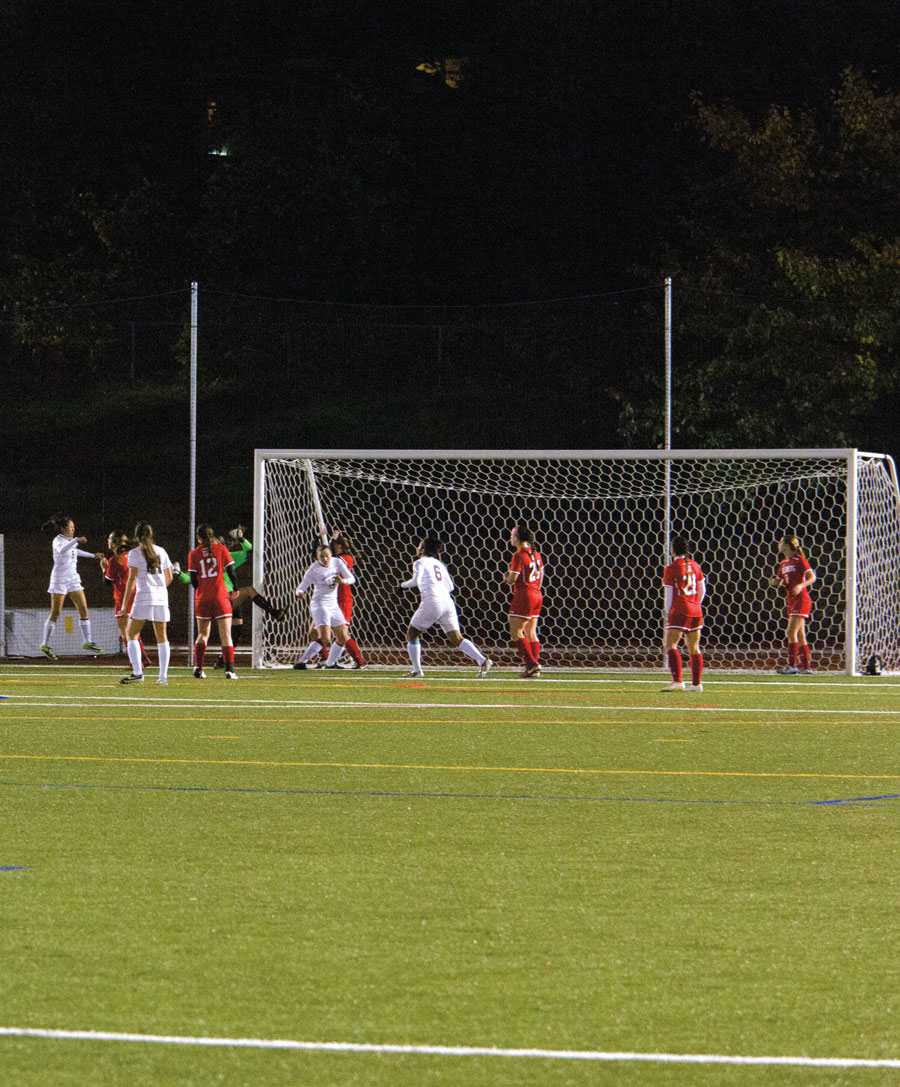
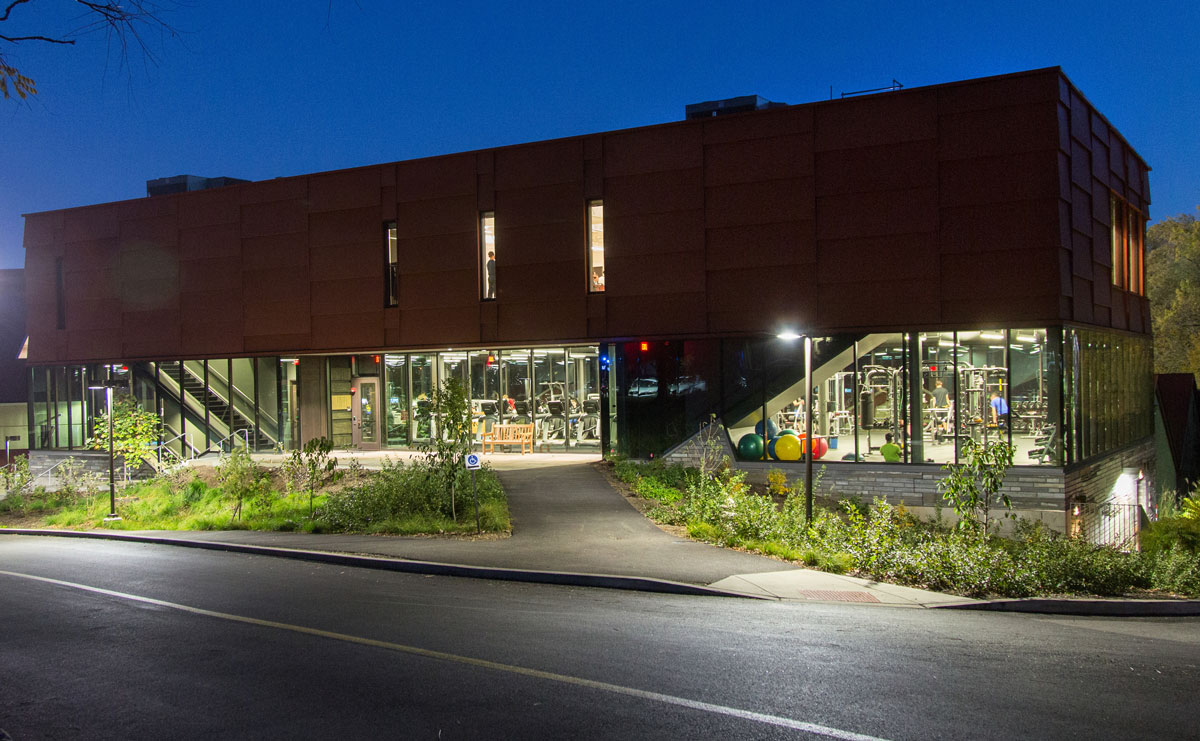
FACILITIES
and resources
- Hormel-Nguyen Intercultural Center at Sproul Hall (which brings the Intercultural Center together with the Interfaith Center and the International Student Center, along with programs and services that support the personal and intellectual development of Asian American, LatinX, multiracial, Native American, queer (lesbian, gay, bisexual and transgender), low-income, international, and first-generation college students)
- Information technology (computer store and repair service)
- Lang Center for Civic and Social Responsibility (service and community information and opportunities)
- Lang Music Building (with 420-seat concert hall and 11 practice rooms)
- Lang Performing Arts Center (with 825-seat Pearson-Hall Theatre, Frear Ensemble Theater, a black box experimental theater, Witky Boyer Dance Studio and Troy Dance Lab, and the List Art Gallery)
- Language Resource Center (audio, video, and computer resources)
- Libraries
– McCabe Library (main library, with 850,000 volumes, including the renowned Swarthmore College Peace Collection)
– Friends Historical Library (Quaker collection)
– Cornell Library of Science and Engineering
– Underhill Music and Dance Library - Martin Greenhouse (supporting botanical research)
- The Matchbox (space supporting wellness, fitness, and theater programming)
- Scott Amphitheater (beautiful outdoor gathering space)
- Scott Arboretum and Crum Woods (peaceful settings for recreation and contemplation)
- Maxine Frank Singer Hall (new building of flexible classrooms and labs to connect the Biology, Engineering, and Psychology departments)
- Van de Kamp Observatory (with 24-inch reflecting telescope)
- Whittier Hall (primarily designed as academic and studio space for the Art Department)

at Swarthmore
COURSE
OFFERINGS
Students may take courses at both Bryn Mawr and Haverford colleges, members of the Tri-College Consortium with Swarthmore. Cross-registration with the University of Pennsylvania is also possible.
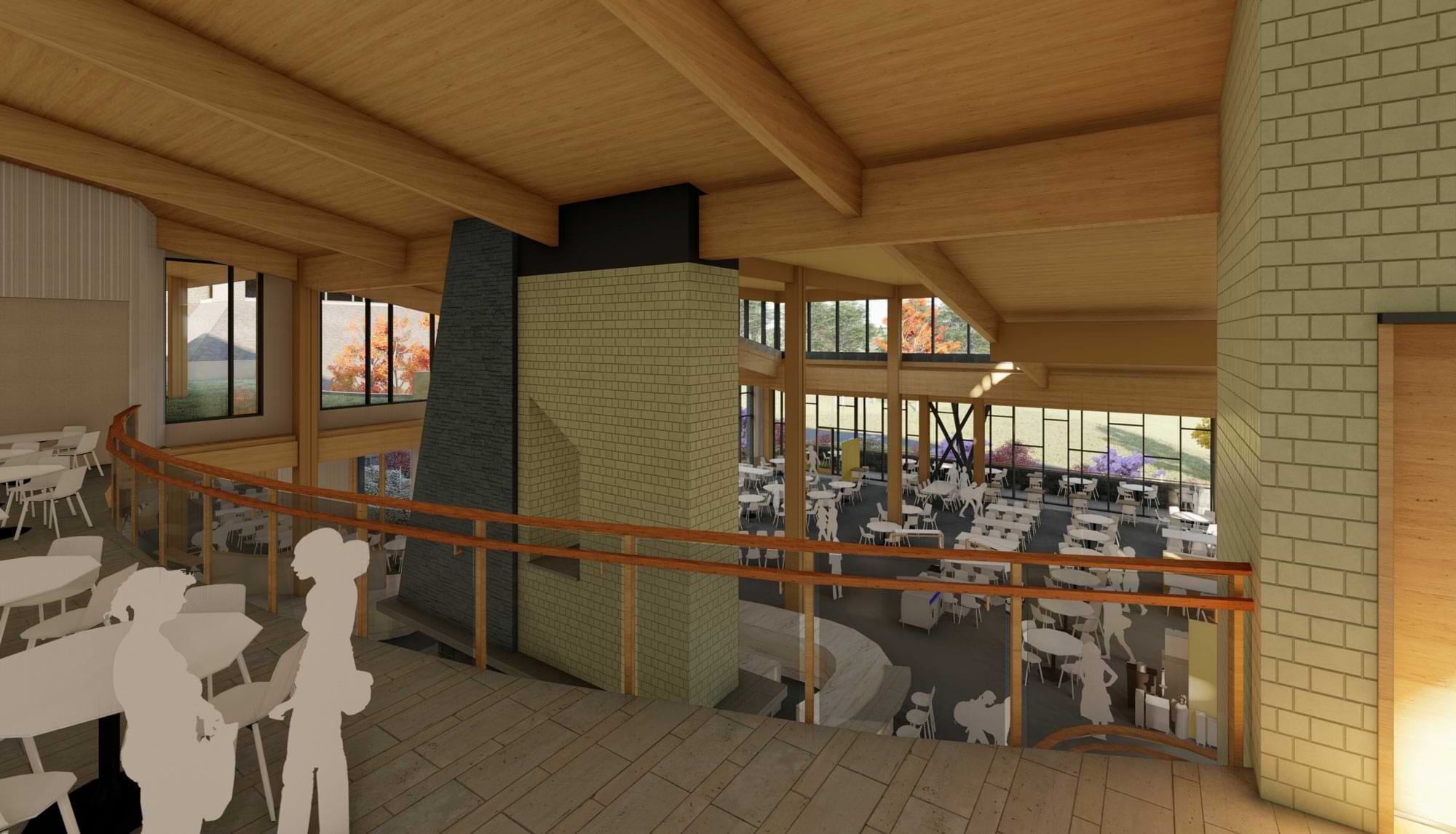
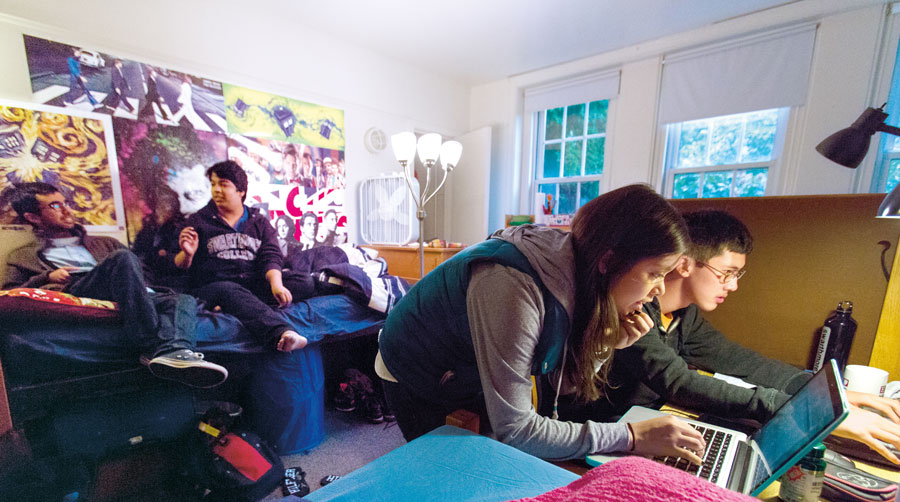
Housing and dining
Typically, about 95% of students live on campus in 18 residence halls, each with Resident Assistants who schedule programs and activities.
Sharples, the College’s dining hall, offers a variety of meal plans and strives to serve local and organic food, minimize food waste, and conserve water and energy. Coffee and snack bars are also available.

options
Community-based
learning
courses
In community-based learning courses, students gain transformative experience. Such courses have included:
- Community Arts Internship (interning at various arts organizations)
- Literacy Research (doing field-based collaborative research)
- Water Quality and Pollution Control (monitoring and analyzing local watersheds and interacting with municipalities and watershed NGOs)
- Introduction to GIS for Social and Environmental Analysis (working with a variety of spatial databases)
- Down But Not Out: The Social Problems of Philadelphia (contributing to an ongoing project at one of the city’s public schools)
- Politics of Punishment (Swarthmore students learning alongside inmates in classes held inside a nearby state prison)


Recent internship sites have included:
- American Red Cross
- Barclays
- Beth Israel Cancer Center
- Centro Nueva Creación
- Chester Housing Authority
- Cooper University Hospital
- DC Fiscal Policy Institute
- First Person Arts
- Foreign Policy Research Institute
- “I Have a Dream” Foundation
- Institute for Race and Justice at Harvard Law
- Japan Center for International Exchange
- Legal Aid Society of New York City
- Muir Woods National Monument
- National Hispanic Institute
- OpenTable
- Planned Parenthood/PA
- Slate Magazine
- UNICEF
- We Care Solar
- Women’s Law Project
- The World Bank
The alumni-sponsored Extern Program encourages students to explore a variety of career fields by pairing them with alumni, providing on-site experience during winter break.
and
FINANCIAL
AID
Application Deadlines
- Fall Early Decision: Nov. 15
- Winter Early Decision: Jan. 1
- Regular Decision: Jan. 1
- Transfer Applicants: April 1
Financial Aid
Fifty-five percent of our student body receives a total of more than $45 million in need-based scholarship or grant aid from Swarthmore.
Tuition includes a $700 allowance for all students to help cover the cost of required course materials.
* Billed costs are accurate as of July 1, 2020. Please refer to our website for current information.
In keeping with Swarthmore’s commitment to environmental sustainability, this viewbook has been printed on paper made from 100% post-consumer waste using vegetable-based inks.
The quotations throughout this book have been excerpted from conversations with current Swarthmore students and professors.


